STAR’s Reading FC Hall of Fame
The Hall of Fame is a work-in-progress project scheduled to complete on the 150th anniversary of Reading FC’s first match in 1872. Each year between 2016 and 2022 11-25 new names will be added (inducted) into the Hall of Fame.
In total there will be about 150 inductees fairly even spread across the 15 decades of the club’s history. Nomination is open to any individual that has played an exceptional or distinctive part in the life of the club. The Hall of Fame should not be seen as a ‘long service’ award. Specifically, it should include players, managers, officials, journalists and supporters.
A range of well-informed supporters has put forward initial recommendations to STAR. These have then been considered in terms of merit and popularity by a panel consisting of STAR Board members and outside experts who will determine the final selection of the latest round of inductees each year. Supporters are welcome to take part in future initial recommendation stages. Please email media@star-reading.org for further details.
1870s
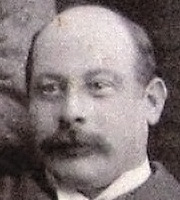
Edward Haygarth
Reading career: 1872-76
c40 appearances
c10 goals
Claim to fame: Reading’s first star player and first England international.
Edward Brownlow Haygarth was an inspiration to Reading FC in its very earliest amateur days. It is likely he played in the club’s first ever game. He is the club’s first recorded goal-scorer, first hat-trick scorer and first international player, as well as the second ever captain of the club. Haygarth’s links to the great and good of football’s early days would almost certainly have helped the status of the new Reading club.
Read more...
Born in Cirencester in 1854 Haygarth came to Reading as part of his training to be a solicitor. He was an all-round sportsman, capable in athletics and a good bat for Reading Cricket Club. At football he played in a position described as ‘back’ in an era where he could face up to seven forwards. He was described as a having a powerful and accurate kick, fearless and heavy and able on occasions to dribble right through the opposition to score.
Newspaper reports enthused about his play and soon he went on to represent Berkshire, to play for the select Slough-based club Swifts and in 1875, at the age of 20, to play at The Oval in the 4th ever football international against Scotland. In the FA records he is credited as being a Swifts player but there is no doubt he was also captaining and playing for Reading regularly at the time. He acquitted himself well in the international, a 2-2 draw, and continued to captain Reading for a while before moving to London, where he played for Wanderers, and then Cirencester where he set up in legal practice.
He retired from football at 23 but continued to play cricket as a leading batsman for Circencester Cricket Club and briefly as a first class cricketer for Gloucestershire. In later life he was a founder member of what became Circencester Golf Club and an important figure in the local community there.
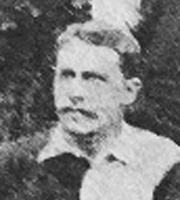
Harry Rogers
Reading career: 1872-79
c80 appearances
c1 goal
Claim to fame: A Reading captain who died on the field of play.
Harry (Henry Francis) Rogers was Reading third, and at the time longest serving captain. It is possible he played in the first ever Reading games, for which no line-ups survive, as he is mentioned in the first team photograph. Rogers was a tall, broad-shouldered, full or half back with good dribbling skills and he also represented Reading Hornets and the Berkshire XI in his playing career which ended with his abrupt and untimely death on the field.
Read more...
Leading the side against Pilgrims on 25 October 1879, despite feeling ill, Rogers succumbed to an epileptic fit during the first half. Consequent upon his death Reading abandoned their fixtures for the rest of the year. A substantial collection for a memorial for Rogers was raised by club members and this still exists as part of his grave in Leamington Spa. Rogers was an architect’s clerk and 25 at the time of his death a much loved member of the club.
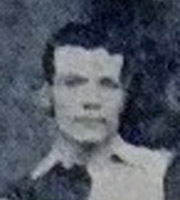
John Morgan
Reading career: 1878-79
14 appearances
Claim to fame: Cup-winning full back and huge figure in early Welsh football.
Though John Morgan only played one season for the club (1878-79) he became our first acknowledged international player (capped for Wales v Scotland) and would surely have won ‘player of the season’ had such an award been in existence. Morgan was a school-master and a former Cambridge Blue. He played full back for Reading in our narrowly-lost, glamour FA Cup tie against eventual winners Old Etonians and in all the club’s matches in the first ever Berks & Bucks Cup.
Read more...
His well-directed corner caused the scrimmage from which the winning goal was scored in the final. At the end of the season he moved to another teaching post in Derby and, despite the best efforts of the committee, could not be enticed back. Morgan is the first Reading player on record to acknowledge the positive effect that spectators could have on the players. He later played for Notts Co and captained Wales, winning 10 caps in all, and scoring against England..
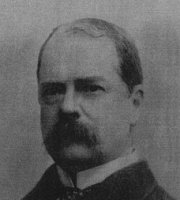
James Simonds
Reading career: 1871-1895
Claim to fame: First, and long-standing, President of the club throughout its amateur days
James Simonds was elected President of the Club on its foundation and retained this position until June 1895 when he joined the breakaway faction of Reading Amateurs as their President. Often described in the early days as the ‘father of Reading FC’ or its greatest friend although there is no evidence he actually played for the club.
Read more...
Simonds was 22 when elected President yet was already an influential and respected figure in the town which was a useful asset to the club and the sport. He often presided over the AGM and probably helped with the finances of the club in difficult times. He held a senior position in Simonds Bank in King St, Reading and also served for long periods on the town council. Simonds was a true Reading patriot from a long-established local family, usually better known for their brewing interests in the town. James also held key offices in the cricket and rowing club and Berkshire CCC. He died in 1905.
The Simonds connection still tenuously exists with the club today. Simonds contemporary relative George Blackall Simonds was the sculptor who created the statue of the Maiwand Lion in Forbury Gardens from which the club’s mascot – Kingsley – is derived.
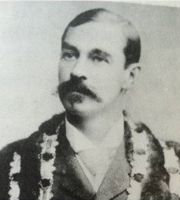
John Martin
Reading career: 1871-c1892
c35 appearances
3 goals
Claim to fame: Influential figure in developing the amateur Reading FC
John Wessley Martin was quite possibly at the foundation meeting of Reading FC and in its first ever match. He’s in the first line-up that we know of for sure and in the first ever team photo, dating from 1872. The indications are that he probably wasn’t a very good footballer, spending about half his 35 appearances in goal and the other half in the forward line (3 goals) and often being dropped for big matches at which he then umpired.
Read more...
But he was a very important administrator, taking on the key role of club secretary from the ineffectual Joseph Sydenham in 1875 when the club was drifting. By 1879 it had become one of the more powerful clubs in the south of England and won the inaugural Berks & Bucks Cup that year. Martin was the secretary of the B&B FA and also founded the Reading Challenge Cup in 1881. This competition stimulated a real growth in the interest in football in the town from which Reading FC was to benefit a decade later. In 1882 he ceased his active involvement with the club but remained a vice-president for several years and a source of support during some years of struggle.
Martin was clearly a strong personality, established as a leading solicitor by 1881 and living in prosperous Downshire Square. He was an active worshipper at Reading Minster and Mayor of Reading by the age of 40 and again at 58 – and a force in local amateur dramatics. Martin had two younger brothers who also played for Reading; Bill was an architect, while Fred became a local solicitor.
1880s
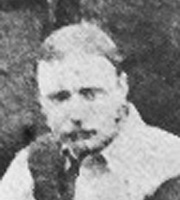
Charles Field
Reading career: 1876-87
c150 appearances
c30 goals
Claim to fame: A loyal club man and a great townsman.
Charles Field was the eldest of the three Field brothers and though he did not reach the same heights as his brother Edgar on the playing field he made more of a contribution to Reading FC and the life of the town. He made his debut in 1876, was a member of Reading’s first trophy-winning team in 1879 and continued to play, usually on the left wing, to the advanced age (for those times) of 37, his last game being in 1887. In all he played ‘first class football’ for 20 years.
Read more...
Charles captained the team on occasion, represented both Berks & Bucks and Oxfordshire in county matches and sat on the club committee for several years – all the while combining his playing career with high profile roles in the town as the deputy coroner, solicitor, councillor and, later in life, three times Mayor of Reading. He died in 1936 at the age of 86, recognised as the ‘Father of Reading Corporation’ and a freeman of the borough. His association with Reading FC continued into the 21st century as the club’s solicitors in Madejski’s time were Field, Seymour, Parkes.
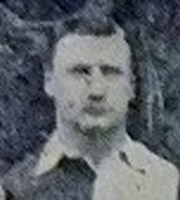
Edgar Field
Reading career: 1876-87
c120 appearances
c2 goals
Claim to fame: long-serving captain, England international and FA Cup winner.
Edgar Field was the best known of the three Field Brothers, from a Wallingford family, who played for Reading in the 1870s and 1880s. His brother Charles was inducted in 2017. A tall and heavy-set full-back he made his Reading debut in 1876 and was captain of the club from 1881 to 1888 but his principal honours came elsewhere. He won the FA Cup in 1880 with Clapham Rovers and caps for England against Scotland in 1876 and 1881 (becoming the first international to score an own goal!).
Read more...
Edgar was a leading figure in football in the area, frequently playing for the Berks & Bucks FA County XI and often refereeing local club matches. In middle age he moved away from the town and worked as an accountant in Derby. Amongst his records recently come to light was a photograph of the England team of 1876. It is the oldest England team photograph in existence.
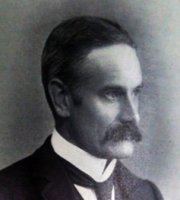
Stanley Hayward
Reading career: 1875-89
Apps: 200+
c7 goals
Claim to fame: Record appearance-maker for amateur Reading FC and one-time club secretary
A Reading man, initially a half back in 1875 but converted to a goalkeeper after two seasons and was a regular player until 1889. He was in Reading’s first Berks & Bucks Cup win in 1879, played for the Berks & Bucks FA and was regarded in his prime as a fine keeper worthy of England consideration. Hayward could be quite an attacking goalie, scoring six times from that position including two in a match once. With 200 known games Stanley is probably the record appearance maker for the amateur Reading FC.
Read more...
He became club secretary in 1883 (until 1889) and was also secretary of the Reading Cricket and Tennis Clubs. He became a successful businessman and accountant and served for 35 years on the Council, becoming Mayor of Reading in 1918 (the third of his team-mates from the 1870s to do so).
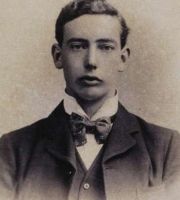
Tom Skurray
Reading career: 1884-1895
120 appearances
32 goals
Claim to fame: Connected the Coley Park era with the Southern League
Skurray was the young pirate who became the old war-horse. At 14 Tom was the captain of Reading Pirates and at 16 made his debut for Reading in 1884. At 17 he joined the Reading FC committee (until 1889) and started a chemistry degree at University College, London. Student life didn’t stop Tom from playing regularly on the wing in our Coley Park days. In later years he sometimes dropped back to the half-back line.
Read more...
He became an expert brewing chemist, working at Morlands in Abingdon, but still found the time to play at Caversham Cricket Ground after our move there in 1890. Tom was a member of our 1892 Berks & Bucks Cup-winning XI and continued to be an asset in our first Southern League season, 1894-95. Even at the time it was seen as remarkable that someone who played in front of 50 people at Coley Park could be playing in front of 4,000 in the Southern League 10 years later. The old war-horse, as he was called, had bridged the eras. In later life he became a nationally known spokesman for the brewing industry and a wealthy man.
1890s
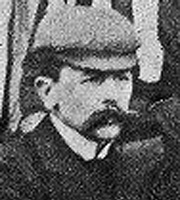
Horace Walker
Reading career: 1880-96
c100 appearances
c20 goals
Claim to fame: The man who saved Reading FC and turned it professional at Elm Park.
Horace Walker’s involvement in Reading FC lasted from 1880 – when he made his debut as a 16 year-old – until 1896 by which time he had fulfilled the formal roles of player-manager, secretary, treasurer, and chair of the committee. But this list of roles do not tell the full story of his influence on the club for, in the dark days of 1889-90, he essentially saved it from dissolution and re-made it into a modern outfit capable of sustaining a position amongst the highest rank of southern clubs.
Read more...
As a player Walker was a speedy winger and regular goal-scorer whose last match was in 1893. He was also a noted athlete across southern England. From a Reading family and from working at Huntley & Palmers he had connections throughout the local sporting realm that enabled him to reform the club. He was the bridge between the truly amateur days of Coley Park and the much better supported club in its Caversham days. As a result of his efforts he became the first life member of the club and was twice awarded a considerable honorarium (gift) by the members. He was a well-known and popular figure as both a football administrator and referee.
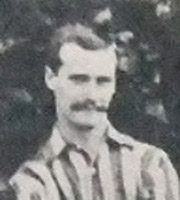
Joey Warburton
Reading career: 1890-95
c60 appearances
c40 goals
Claim to fame: The man who made sure Reading FC was called Reading FC.
Joey Warburton was a well-loved local hero who played several important roles in the decade that transformed Reading from a struggling amateur outfit to a nationally recognised professional club. He scored the vital goal in Reading’s first trophy win for 13 years, became club secretary at a key moment and soon after an important director when the club turned professional.
Read more...
Joey Warburton was born in Thatcham in 1867 and moved to Reading in his youth to work for Jackson’s general and scrap metal merchants in Oxford Road, eventually becoming managing director there. He was active in local football and cricket at a young age and played for Garfield and Earley before joining an improving Reading team and making his debut in September 1890. Joey played mainly as a right-sided forward. He was almost ever-present in 1891-92 and scored the opening goal in the Berks & Bucks Cup Final in 1892. Reading won 2-0. Thereafter he featured less regularly in the first team though he did play against Old Carthusians in 1894 (the programme still exists for this match) and a few times in our first Southern League season 1894-95. He was a popular mainstay of the reserves towards the end of his career.
When the club turned professional in the summer of 1895 Warburton retired from playing and took on the role of Club Secretary and almost his first act was to fight off the claims of the breakaway Reading Amateurs FC to the title of ‘The Reading Football Club.’ This he managed successfully. The club became a Limited Liability Company in 1897 and Warburton, with his long association with the club and his playing experience, became one of the most influential directors. He died in 1939.
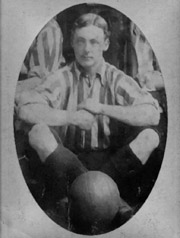
Frank Deane
Reading career: 1890-95
c160 appearances
c10 goals
Claim to fame: Last captain of amateur Reading who led a revitalised trophy-winning side.
Frank Deane was the last captain of Reading when it was an amateur club. He had been well-known as the captain of neighbouring Caversham FC before putting his main footballing efforts into Reading FC from 1890 for whom he scarcely missed a match thereafter.
Read more...
His transfer to Elm Park, despite the interest of Burnley and Clyde, was a major coup for Reading. Johnny was 33 when he signed in October 1898 and in November 1899 went on a FA tour of Germany and Austria. The FA XI won all four matches against the German and Austrian national sides by an aggregate of 38-4! Holt’s form was good enough to win one more cap in March 1900 and so he became our first professional England international.
He also became the first England player to win 10 caps without being on the losing side. Johnny carried on playing until he was 37, making 61 Southern League appearances for us. He scored his only two goals for the club in a 8-0 away FA Cup win at Wycombe. Upon retiring in 1902 he was elected on to Reading’s board of directors but had to stand down when the FA refused to reinstate him as an amateur.
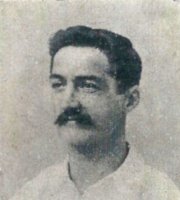
Johnny Holt
Reading career: 1898-1902
Apps: 112
2 goals
Claim to fame: The first professional Reading player to be picked for England
Despite standing just 5ft 4 tall Johnny was a formidable centre half who is credited with inventing the sliding tackle and was nicknamed ‘The Pocket Marvel’. He made his name at Everton, where he won the League championship and nine England caps.
Read more...
His transfer to Elm Park, despite the interest of Burnley and Clyde, was a major coup for Reading. Johnny was 33 when he signed in October 1898 and in November 1899 went on a FA tour of Germany and Austria. The FA XI won all four matches against the German and Austrian national sides by an aggregate of 38-4! Holt’s form was good enough to win one more cap in March 1900 and so he became our first professional England international.
He also became the first England player to win 10 caps without being on the losing side. Johnny carried on playing until he was 37, making 61 Southern League appearances for us. He scored his only two goals for the club in a 8-0 away FA Cup win at Wycombe. Upon retiring in 1902 he was elected on to Reading’s board of directors but had to stand down when the FA refused to reinstate him as an amateur.
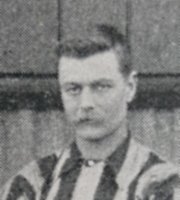
Stan Justins
Reading career: 1887-1897
Apps: 194
2 goals
Claim to fame: Loyal club man who played for both amateur and professional Reading FC
Stan played full back for Reading between 1887 and 1897 having learned his football with South Reading, often the second-best team in the town. His was an unusually long career for those days – even more so given that his career spanned both the amateur and professional eras on the club.
Read more...
Stan was deputy captain and acting captain of the club on many occasions. He was one of very few players of the amateur Reading FC to turn pro successfully. A level-headed man in a crisis on and off the pitch and key part of the successful early 1890s trophy-winning side and later made 39 appearances in the Southern League. Stan worked for GWR and in later life lived in Waverley Road, overlooking Elm Park.
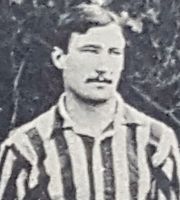
Henry Hewitt
Reading career: 1890-1893
40 appearances
52 goals
Claim to fame: Reading’s first crowd-pleasing star centre-forward
Henry Hewitt was the star centre-forward of the first Reading team that regularly drew four-figure crowds. He was a fast, skilful forward whose play was described as ‘spicy and full of vigour’ – a great shot and a brilliant dribbler capable of taking on defences on his own. Hewitt inspired secretary-manager Horace Walker’s revitalised Reading to many important victories including the significant re-capture of the Berks & Bucks Cup in 1892.
Read more...
He scored five in a game twice, including all five goals in a 5-5 draw at Clapton, and four three times (once against Tottenham Hotspur). In 1893 he moved to London and sadly missed the train to a vital (lost) FA Cup tie at Swindon. It was the beginning of the end! He later went on to play as an amateur for Clapton in the first Southern League season, 1894-95. His goals to games ratio must be one the best in Reading’s history though astonishingly his feats have rarely been recognised. He was also a prolific scorer for Reading Cricket Club with at least one unbeaten century to his name.
Before joining Reading in 1890 he had been the captain of Devon county team. Hewitt was born in India but studied in England, graduated from Oxford University and became a schoolmaster.
1900s
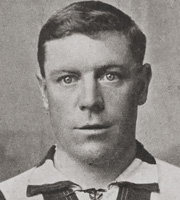
Fred Bartholomew
Reading career: 1904-57
FL 6 apps
SL 158 apps
9 goals
Reading total 178 appearances 9 goals
Claim to fame: Over half a century at Elm Park as player, trainer and groundsman.
Fred had a fairy-tale introduction to his Reading career – at Elm Park to watch a local cup final in Easter 1904, he was asked to make up the numbers for one of the teams and ended up scoring a hat-trick. He was immediately signed by Reading and he stayed for over 50 years, first as a player and then as a trainer and groundsman, retiring in 1957.
Read more...
Although mainly a right sided defender, Fred played in every position for the club, making 193 League, Southern League and FA Cup appearances, scoring 11 goals, a total that would have been much higher but for the War years during which he rose to the rank of Company Quartermaster Sergeant. Known affectional as ‘Old Bart’, Fred can claim to be among the club’s greatest servants and certainly among the most long-lasting. He had a sense of humour too. On being offered the captaincy by the manager in a bid to cut down drinking in the club he declined saying he thought he was one of the worst offenders!
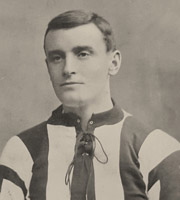
Herbert Smith
Reading career: 1900-09
160 apps
Claim to fame: Reading’s most capped England international, Olympic gold medallist and a true amateur sportsman.
One of the last great amateur players in the new age of professionalism, Herbert captained Reading for the first eight seasons of the 20th century, guiding the club to runners-up spot in the Southern League, our highest position there, and winning the Southern Charity Cup in 1905. He made 153 Southern League appearances and 7 in the FA Cup.
Read more...
His ‘dexterous left foot was almost legendary’ while he was ‘scrupulously fair’ and this led to him winning four full England caps in 1905-06 (still the most yet by a Reading player) plus 14 England amateur caps. He also won a soccer gold medal at the 1908 Olympics as well as captaining Oxford City to the final of the Amateur Cup. Herbert later acted as president for Oxfordshire FA for 32 years and is thought a genuine candidate for the title of Reading’s greatest player. Smith was described as ‘a total abstainer who smokes moderately’ and ‘is idolised by the players at his club’.
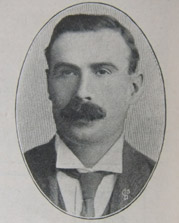
Harry Matthews
Secretary/Manager
Claim to fame: our longest serving manager and sometime club saviour.
Harry was a long-standing servant of the club whose involvement dates back to the mid-1890s when he was the secretary-manager of the reserves. By 1902 he had taken on that role with the first team and remained in that position until 1919, making him our longest serving manager by some distance.
Read more...
He was our first paid manager to pick his own team, albeit subject to the directors’ approval, and guided the club to their first professional trophies. A skilled administrator, Harry saved the club from several financial disasters and in 1911, when the board voted to wind up the club, he ‘forgot’ to minute the decision and raised enough public support to enable the club to carry on. Harry was particularly adept at finding star players from the Army and other unlikely sources. He had the hugely difficult task of sustaining the club during WWI with friendlies and matches in London League. In total he managed the club for over 500 peace-time first team games, three runners-up positions in the highly competitive Southern League Division One and the SL Division Two title at first time of asking in 1911.
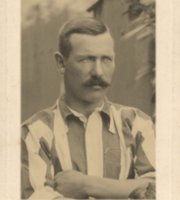
Ernie Watts
Reading career: 1896-1908
Apps: 177
8 goals
Claim to fame: Signed three times for Reading – once for just 12p!
Born in Woolhampton, west Berkshire, in 1872, former soldier Ernie was one of our first professional players. He signed from Tilehurst for the princely sum of 2/6d (12.5p) in 1896. Ernie had also previously played as an amateur guest in 1893 when serving with the Lancs Regiment, from whom we often borrowed players. At 5ft 10ins and weighing 12st 8, Ernie was a physical presence at either right half or occasionally as an emergency goalkeeper and was always known as ‘Big Wattie’.
Read more...
After three successful Southern League seasons, Ernie moved to Notts County, playing 17 First Division games for them before returning to Elm Park a season later. Virtually ever-present for the next four seasons, Ernie also played in an FA trial alongside a record four other Reading players; a trial that saw Herbert Smith picked for England. In 1903 Ernie was on the move again, playing for New Brompton (Gillingham) and Clapton Orient before a third spell at Reading, which saw him add just two more appearances to the 146 Southern League games he had played for us, having scored nine times. A fine all-round sportsman, Ernie also played cricket for Berkshire.
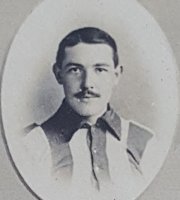
Billy Henderson
Reading career: 1897-1906
Apps: 177
Claim to fame: Tough and successful defender in a strong Southern League side
Midlothian-born Billy made more appearances for Reading in the 1910s than any other player, a total of 231 in all competitions (including 143 SL and 34 Cup). He was a tough-tackling defender who was warned by the directors over his persistent fouling on more than one occasion. Despite this, he signed for Reading three times with spells at Southampton and Everton in between.
Read more...
His physical play saw him form an impressive full back pairing with the more cultured Herbert Smith with great success. Billy missed only one match in 1904-05 when Reading finished runners-up in Southern League Division One and were joint-winners of the Southern Charity Cup in that same season. When his playing career had finished he emigrated to the USA to work in a Colorado salt mine!
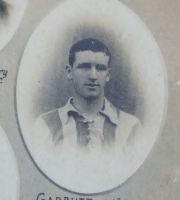
Willy Garbutt
Reading career: 1903-1905
8 appearances
1 goal
Claim to fame: The father of Italian football and source of our greatest European triumph
Widely known as ‘the father of Italian football’ Willy Garbutt’s Reading career was brief – only 8 Southern League appearances and one goal – but he also provided the link for our greatest (yet) European adventure – the 1913 tour of Italy.
Read more...
Garbutt joined Reading in 1903 from the Army but played only sporadically, mainly as a right winger. It was not until late in 1905 he had a decent run in the first team at which point he was snapped up by Arsenal for a ‘goodly sum’. In two and half seasons at Arsenal and four at Blackburn he made 134 First Division appearances retiring at 29 through injury.
He went Genoa, became manager there and won three league titles and was dubbed ‘the English Mister’. It was during his first summer there (1913) he was instrumental in inviting Reading to tour Italy and play Genoa, among the five matches arranged. During the tour Reading were credited with being the finest football team ever seen in Italy – a claim perhaps nowadays under some threat.
After Genoa (where he won Serie A three times) he also managed AS Roma, AC Milan and Athletic Bilbao where he won La Liga. Most of all he was revered as an important early influence on the great Italian coach Vittorio Pozzo who guided the Azzuri to two World Cup triumphs. He was also cricket coach at Genoa but that led to rather less!
1910s
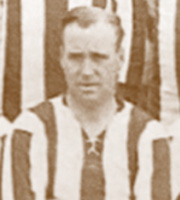
Allen Foster
Reading career: 1911-1915
146 appearances
67 goals
Claim to fame: FA Cup and European hero and WWI casualty.
Allen Foster joined Reading in August 1911, for a transfer fee of £75. He was virtually ever-present for the next four seasons and top scorer in each of those seasons, with a total of 67 league goals from 146 appearances. He is particularly remembered for two scoring feats, an FA Cup winner against Aston Villa and a hat-trick against AC Milan. Tipped for international honours, he was killed in battle in the First World War.
Read more...
Allen had begun his football career with Rotherham Town, a club playing in the Midland League (which later amalgamated with Football League club Rotherham County to form Rotherham United). Moving to Football League club, Bristol City in January 1909 he made 13 appearances; scoring one goal, before transferring into the Southern League with Reading in 1911. As a left-footed inside forward he formed a deadly partnership with Joe Bailey.
He scored a stunning volleyed winner in the FA cup 2nd Round replay against First Division, Aston Villa in February 1912, prompting a bid of £750 from Villa, which the Reading FC directors rejected despite the Club being in significant financial difficulties at the time. Villa were a leading side in that era as were Manchester United who Reading held in the next round (last 16) before losing in the replay.
During the Club’s successful end of season tour of Italy in 1913, he scored a hat-trick against Italian giants AC Milan in the Club’s 5–0 victory. The result prompted the leading Italian newspaper Corriere della Sera to report that “without doubt, Reading FC are the finest foreign team seen in Italy.” The following year he played and scored on Reading’s tour of Holland. He was tipped for an England call up but war intervened.
Allen was born in Rawmarsh, near Rotherham in South Yorkshire, in late 1887. Having married Beatrice Jennings in the spring of 1912 in Bristol the couple moved into a house at 14 Kent Road in Reading (literally yards from Elm Park).
During 1915 Foster, along with many other professional footballers volunteered for active service, joining the 17th Middlesex Battalion (The Footballers’ Battalion). At 4.00 a.m. on 8th August 1916 at Guillemont, on the Somme battlefield Allen was part of the 17th Middlesex attempt to attack German trenches north of the village. Early in the advance he was wounded in the arm, thigh and abdomen. After being recovered by stretcher bearers he was evacuated to a Casualty Clearing Station at Corbie, where sadly he died of his wounds. Allen is buried in Corbie Communal Cemetery Extension.
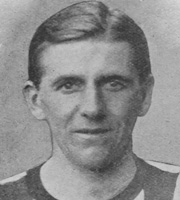
Joe Bailey
Reading career: 1911-21
201 appearances
9 goals
Claim to fame: A scorer of significant goals and a war hero to boot.
Achieving an incredible scoring ratio of one goal in every two and half games there have been few players who were more popular with Reading supporters than Joe Bailey. Although named Walter he was known as Joe and was nicknamed ‘Bubbles’, he joined Reading as an amateur in 1911, but after injury ruled him out of the 1912 Olympic squad he turned professional. A regular goal scorer throughout his career he forged a dynamic strike partnership with Allen Foster.
Read more...
As well as scoring in every one of the club’s five Italian tour games in 1913, Joe was our top scorer in the club’s last season in the Southern League and also the first season in the Football League; that included netting Reading’s first-ever League goal, against Newport County.
At the outbreak of the Great War Joe volunteered for the Middlesex Regiment’s Footballers’ Battalion as a private. He earned a commission and ended the war as a captain in the Suffolk Regiment, having been awarded the Distinguished Service Order and the Military Cross, with two bars, making him the most decorated officer in that regiment.
Joe left Elm Park in 1921 to become a cricket coach at Warwick School but not before the club had arranged a benefit game, for which he famously sold a ticket to the future King Edward VIII.
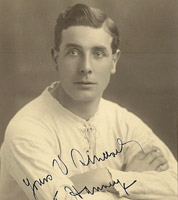
Ted Hanney
Reading career: 1910-21
123 appearances
11 goals
Claim to fame: Olympian, WWI hero and record transfer fee.
Born in Brock Barracks on the Oxford Road, where his father, John, was the Quartermaster Sergeant of the Royal Berkshire Regiment, Ted Hanney had Reading Football Club and the army in his blood. He was a tall, dashing defender and it is not too strong to say he was one of Reading FC’s greatest ever players.
Read more...
He was tough, but also quick and skilful; being selected for the 1912 Olympic squad and played in Great Britain’s 7-0 quarter final win over Hungary. Sadly he sustained an injury and could not play in the final as the team won gold by beating Denmark 4-2. On returning to Elm Park he signed professional forms but he was sold shortly afterwards to Manchester City, for a huge, at that time, £1,250 fee.
Ted volunteered to join the 17th Middlesex (Footballers’ Battalion) on 1st June 1915, and in the summer of 1916 found himself on the Somme battlefield in Delville Wood. Badly injured in several places he was evacuated home. He spent 37 days in hospital but just two months later he pulled on a blue and white shirt and played for Reading at Elm Park.
After the War, and following two seasons with Coventry City, he returned to captain the Biscuitmen. Some years later he coached in Germany with Stuttgart and Wacker Munich. Reading was always Ted’s home and he returned to the town, where he ran a pub and continued to take an interest in local football, running coaching sessions at Elm Park during the Second World War and was the Berks and Bucks F.A. Coach. Ted continued living in the town until his death in 1964 at the age of 75.
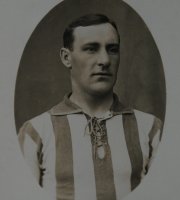
Jack Smith
Reading career: 1910-22
Apps: 252
Claim to fame: long-serving player who saved Reading from re-election
Captain and right back throughout the 1910s and into our first League season (1920-21), Jack Smith played more Southern League games for Reading (195) than any other player. He was born on the Wirral and had previously played for Blackburn and Portsmouth before joining Reading. He cost the measly fee of £5, possibly on account of the broken leg from which he was recovering, in the summer of 1910.
Read more...
Jack captained the first-ever Reading team to win promotion (from Southern League Div Two in 1911). After the war the club was elected to the newly-formed Division III but got off to a struggling start. In December 1920 Jack became our first player-manager and guided the club away from the threat of having to apply for re-election in our first League season – and that was the closest we ever came to such a fate.
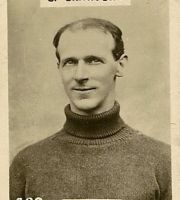
Syd Crawford
Reading career: 1913-22
157 appearances
Claim to fame: The greatest penalty-saving goalie in our history
Syd was a Scot who joined Reading in 1913 after First Division experience with Arsenal. Crawford was Reading’s regular goalie either side of WWI making 157 appearances.
Read more...
Reading were a strong Southern League side in those days finishing runners-up in 1915. Syd also played in our first Football League game in August 1920 and was a regular for two league seasons before joining Millwall.
He was a fearless keeper with an uncanny and unconventional knack of saving penalties, stopping over 50 in his career. Syd stood to one side of the goal tempting the taker to aim for the bigger space. His most famous save was in the last minute of an FA Cup tie against Chelsea. The save earned Reading a lucrative replay whilst causing his wife and a club director to faint! The replay was watched by 34,000 at Stamford Bridge – the largest crowd Reading had yet played before.
1920s
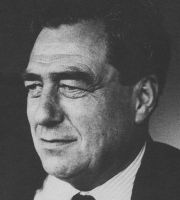
John Arlott
Reading career: Supporter from the 1920s onwards
Claim to fame: The first well-known personality to speak up as a Reading fan
John Arlott was the first nationally, indeed possibly internationally, known supporter of Reading FC. Whilst famed as one the very greatest cricket broadcasters he was also for some time a football journalist and kept his support for unfashionable Reading public in the press rooms of the nation and in his biographical work.
Read more...
Leslie Thomas John Arlott OBE; a journalist, writer, poet and wine connoisseur was born on 25th February 1914 in Basingstoke, North Hampshire, an area that has done much to support the club over the years. An avid football supporter, as a young man he cycled regularly the 17 miles from his Basingstoke home to watch the Biscuitmen at Elm Park. He notoriously failed his entrance examination for Cambridge University by leaving the room after the first hour to go and watch a Reading cup tie.
After leaving school and brief employment as a clerk at Basingstoke Town Hall and four years working as a records clerk at Park Prewett Mental Hospital in Basingstoke John Arlott joined the Southampton County Borough Police Force where he served for 12 years rising to the rank of sergeant; using every opportunity to watch Hampshire Cricket Club.
Coming to the attention of the BBC in 1945 he was invited to join its Overseas Service in 1946 initially to commentate on England’s warm up games for India’s tour of England he made such an impression that he was invited to commentate on the subsequent Test matches, thus launching a 34 year broadcasting career in which he commentated on every home Test match in his popular poetic style aided by a distinctive voice, described by fellow Guardian journalist, Frank Keating as an, “articulate, leisurely, confiding countryman’s burr”. His contribution to British radio is commemorated in the Royal Academy’s Hall of Fame.
A liberal and humanitarian, he stood for Parliament as a Liberal Party candidate unsuccessfully twice. He was an outspoken critic of the England selectors’ initial failure to select Basil D’Olivera for the 1968 tour of South Africa amidst allegations of South African political interference with the selection committee. A result of which was his vow never to commentate on South Africa again, but following the cancellation of the 1968 and 1970 tours South Africa was ostracised from World cricket until the release from prison of Nelson Mandela in 1991.
John Arlott retired from cricket commentary and journalism at the end of the 1980 cricket season and moved to Alderney, where he died peacefully in his sleep on 14 December 1991.
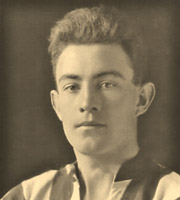
Billy McConnell
Reading career: 1924-28
161 appearances
1 goal
Claim to fame: Tough, title-winning full back, once our most capped player
McConnell joined from Slough, who he had helped win the Berks & Bucks Cup at the age of only 16, in May 1924. He was virtually ever present at left back for the next four seasons, until injury ended his career. A tough competitor who ‘used his strength to the full’ he was Reading’s most capped international for 70 years, being selected for 10 consecutive Irish internationals.
Read more...
Injury and club commitments restricted him to eight starts. He won a Division Three South championship medal with the Biscuitmen in 1925-26. One of our most popular pre-war players, Billy broke his ankle while courageously scoring his only goal for us against Middlesbrough in 1927. He made several comeback attempts, including a brief spell in goal for the reserves, before finally quitting. He then became a Football League linesman and refereed several wartime games at Elm Park as well as playing in the town’s first ever floodlit game staged at the old Oxford Road Greyhound Stadium in September 1934.
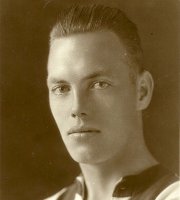
Alf Messer
Reading career: 1923-1930
Apps: 295
19 goals
Claim to fame: International-class kingpin of Reading’s Div III (S) title-winners
Without doubt one of Reading’s greatest players of any era. A dominant centre-half who was tipped for England honours and reckoned to be the best uncapped player of the day.
Read more...
Messer signed for Reading in 1923 and played almost every game until his transfer to Tottenham in 1930 for the large fee of £2,000. He was in the first Reading side to win a Football League promotion in 1926 – the Division III (S) title – and the first side to reach the FA Cup semi-finals the year after. Alf became club captain in 1928. After he moved to Spurs Reading’s defence disintegrated and the club were relegated in 1930-31. He played 295 times for the club scoring 19 goals – a high number for a defender in those days.
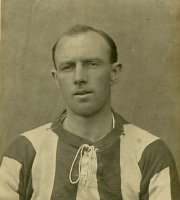
Bert Eggo
Reading career: 1921-1929
Apps: 312
2 goals
Claim to fame: Captain of our first League divisional title-winners in 1926
A calm and skilful right back from Scotland Bert played 312 games for Reading, the most pre-WWII appearances. Previously with Hearts and Sheffield Wednesday he signed in June 1921 “for the price of an old song” for our second League season.
Read more...
He captained the side that won promotion in 1926 from Division III (S) and reached the FA Cup semi-final in 1927 and was seen as the calm and controlling influence in the dressing room. At the age of 34 he retired from the game but continued to live in the town for a while and no doubt watched Arthur Bacon in the Reading team. Sadly they never played together!
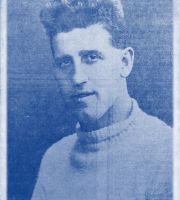
Joe Duckworth
Reading career: 1924-1930
225 appearances
Claim to fame: Consistent and brave goalkeeping in our first title-winning team
Joe served four years in the army during WWI (having tried to join whilst under-age) before a brief spell with First Division Blackburn, his home town club. He moved to Aberdare where, as an opponent, he so impressed Reading we signed him in 1924. Over the next four seasons he missed just one league match as the club rose from the depths of Division Three South to mid-table respectability in Division Two.
Read more...
He won a Division Three South champions medal in 1925-26 (as an ever present) and played in every game in the run to the FA Cup semi-final the following season. His appearance record is remarkable given his outstanding bravery in an extremely physical era for goalkeepers. Perhaps his finest moment was keeping a clean sheet in an FA Cup tie in 1929 as Reading knocked out the league champions-elect, Sheffield Wednesday. Joe left Reading in 1930 for Brighton and later returned to Lancashire where he worked as a deckchair attendant on Blackpool beach.
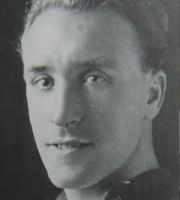
Frank Richardson
Reading career: 1926-1930
103 appearances
55 goals
Claim to fame: A striker who made the difference, helping us to our first FA Cup semi-final and highest league position
Frank was the definition of a great deadline day transfer swoop – if they had them back in 1926. He joined Reading at the age of 29 from Swindon but had First Division experience with Stoke and West Ham under his belt. He played in the last 13 games of the 1925-26 season scoring 12 goals as the Biscuitmen pipped Plymouth (another of his former clubs) to the Division Three South title, including four strikes in the vital last game of the season.
Read more...
Frank was top scorer in Reading’s debut season in Division Two with 19 as we reached our highest league position yet. More memorable was his part in our ten game run to the FA Cup semi-final in 1927. He scored nine times, including four against Manchester U over three games and the only goal in our record home attendance (33,042) victory over Brentford. The fans sang “Rich, Rich, Rich score another goal for me” – one of the first songs for a Reading player, based on the big 1926 hit Chick, Chick, Chick, Chick, Chicken (written by Tommy McGhee).
After turning 30 he was less frequently in the first team and eventually moved back to Swindon in 1930. But he had settled in the Reading area and later coached the youth team in the 1950s and 1960s. When Reading finally, exactly 60 years later, repeated the feat of winning the Division Three title Frank Richardson was the guest of honour and received a very warm reception.
1930s
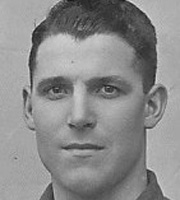
Jack Palethorpe
Reading career: 1930-33
64 appearances
54 goals
Claim to fame: The greatest ‘what might have been’ of the 1930s.
Scandalously under used as a young player, Palethorpe was a prolific scorer and has the best goals per league game record of any Reading player with 54 goals in only 57 starts. Before joining Reading in 1930 at the age of 21 he had scored 65 in 39 games for Maidenhead. Many thought his regular inclusion in the Reading team could have saved the club from the calamitous 1931 relegation.
Read more...
He featured regularly as Reading finished runners-up and fourth in the next two seasons before departing for a large fee to Stoke where he won promotion. He also won promotion at Preston and scored in Sheffield Wednesday’s FA Cup winning side of 1935, leaving Reading fans wondering what might have been, had he stayed.
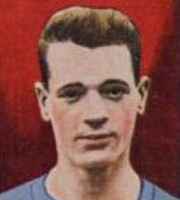
Tommy Tait
Reading career: 1934-39
170 appearances
103 goals
Claim to fame: Instant success and prolific scorer part-funded by Supporters’ Club.
Tommy Tait had already scored goals in all four divisions of the Football League, with Southport, Manchester City, Bolton and Luton, before Reading paid Bournemouth £1,000 for his services in November 1934. Uniquely, £200 of that fee was paid for by the fledgling Reading Football Supporters’ Club and he immediately repaid the fans’ faith by scoring a hat-trick on his debut at Aldershot in a game that also saw him have two other ‘goals’ ruled out for off side.
Read more...
From then on it was goals all the way as Tommy headed our goal-scorers in his first four seasons. A hardworking, aggressive forward, Tommy was also an innovative player who was one of the first centre forwards to roam across the pitch to create space for himself and his fellow forwards, as well as creating confusion among the opposition’s defence. The only black spot on Tommy’s Reading career came on Boxing Day 1934 when he became the first Reading player to be sent off in a League game at Elm Park when he retaliated to persistent fouls by the Millwall defence. Tommy soon got his revenge on Millwall, scoring the goal that knocked them out of the FA Cup a month later to earn Reading a home tie at home to Arsenal. That goal confirmed Tommy’s love of the FA Cup as it was one of 14 that he scored in 15 games in that competition. His dismissal never dimmed his support from the fans so there was uproar when the club announced that Tommy’s contract would not be renewed at the end of the 1937-38 season. The supporters began a petition in an attempt to get their favourite re-signed but Tommy had a better idea, scoring five goals in the next two games to earn himself a new contact.
He finally left Elm Park in 1939, joining Torquay. The start of the Second World War effectively ended Tommy’s playing career although he did return to Reading to make two more appearances as a wartime guest. One of the most popular players in Reading’s history, Tommy died in Cheshire in 1976 at the age of 67.
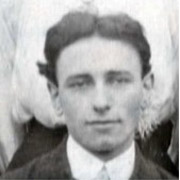
Harry Sirrett
Claim to fame: Local journalist who founded the Supporters’ Club that led to STAR.
As editor of the Football Chronicle H H Sirett was an influential commentator on Reading Football Club and, with the Chronicle holding shares in the club, he attended an Extraordinary General Meeting called in November 1930 by shareholders angry at the team’s poor form. There had been several attempts to form a supporters’ club at Reading. As a concession during the heated meeting, the board reluctantly agreed to allow the formation of a such an organisation.
Read more...
Mr Sirrett acted quickly, arranging a public meeting at the Highways Club, Greyfriars Road the following week and publicised it in the Chronicle’s weekend edition. On 1 December 1930 the Reading Football Supporters’ Club was formed and Mr Sirrett was elected its first chairman. By the end of the season the fledgling club had over 1,300 members. Despite providing valuable donations to the football club, the directors did not appear to approve of Mr Sirrett because, in January 1934, he was banned from the ground after his paper criticised the form of some of the players.
Always a supporter of local football Mr Sirrett was president of Whitchurch United in 1939. Harry had an all-round interest in sport, was particularly fund of racing pigeons and patented a type of dart-board. He died in 1948. Apart from a short hiatus in the late 1940s the Supporters’ Club continued its existence until 2002 when it was essentially transformed into STAR.
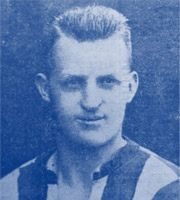
Arthur Bacon
Reading career: 1929-32
67 appearances
44 goals
Claim to fame: Holds the club record for most goals in a single League game.
A big, burly centre forward who signed for a relatively large fee from Manchester City in 1929. Bacon scored an amazing 29 goals in 32 games in our 1930-31 relegation season. This included a still-existing club League record of 6 in the 7-3 defeat of Stoke City, one of which included putting the keeper in the back of the net as well! This was Reading’s last victory at this level of League football for 55 years.
Read more...
His goal-scoring exploits weren’t over when he left Reading in 1932. Whilst at Coventry he scored 15 goals in only 5 games, including 5 and 4 in consecutive matches. Sadly Bacon missed playing in the same Reading side as Bert Eggo by a year! He died during an air raid in WWII while serving as a volunteer fireman at the Rolls Royce aero engine factory in Derby.
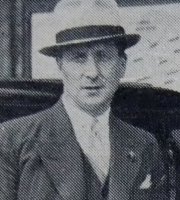
Billy Butler
Reading career: 1933-1939
Apps 67
16 goals
Claim to fame: Famous face on the wing who became innovative manager
Billy was a success as both player and manager at Elm Park. He was a veteran winger with three FA Cup winners’ medals (all with Bolton) and one England cap when he joined Reading in 1933. After 67 appearances he became manager in 1935 in succession to Joe Smith.
Read more...
He was innovative, writing his own programme notes, installing a gymnasium at Elm Park and taking players out into the community. Whilst he came close to winning promotion, winning over 50% of his League matches in charge, his only managerial honour was the Southern Section Cup in 1938 (a ‘prototype’ of the Checkatrade Trophy). Under Billy Reading finished 3rd, 5th and 6th. After the war he coached in southern Africa.
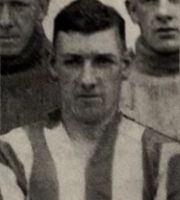
Albert Hayhurst
Reading career: 1933-1939
247 appearances
12 goals
Claim to fame: Consistent centre-half in a record-breaking team
A Yorkshireman Albert joined Reading from Luton in June 1933 on a ‘free’ and went on to play in virtually every game for the next five seasons. He was a late starter, effectively beginning his league career at 28 but made up for that as a wonderfully consistent player, first at centre half and later at right back.
Read more...
In his five seasons at the heart of the defence Reading finished third, second, third, fifth and sixth but never quite managed the one promotion place on offer. However Albert was very much part of the Reading defence that set a new Football League record of 55 undefeated home matches between 1933-35 which stood for thirty years.
Albert was also an inspirational captain and he led Reading to victory in the Southern Section Cup in 1938, our only honour of the decade. It was in another cup game that Albert played the match of his life, marking Arsenal’s legendary free-scoring Ted Drake out of the game against the Gunners in 1935.
Released by Reading at the age of 34 in 1939, WWII virtually ended his career but he did return to Elm Park for one war-time appearance. As well as a great career as a footballer, Albert was a fine cricketer who played seven times for Warwickshire in 1934 and was still playing minor counties cricket in 1953. Albert died in Reading in 1991.
1940s
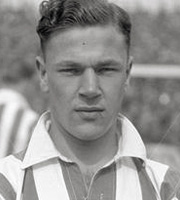
Maurice Edelston
Reading career: 1939-52
223 appearances
80 goals / Journalist
Claim to fame: Olympian, our last great amateur and BBC commentator.
Maurice Edelston was another of Reading’s Olympians and another who lost some of his best playing years and chance of playing for England to the war. As a teenager he played for GB in 1936 Berlin Olympics and won a total of 10 amateur international caps and 5 wartime caps for England. Edelston was a clever and cultured, goal-scoring inside right who signed for Reading in April 1939.
Read more...
He played the three matches of the aborted 1939-40 and then had to wait another 7 years to resume his league career. Clearly he had saved up his goals for he scored hat-tricks in each of his first two home league games, becoming the only amateur ever to do so in league football. He turned professional soon after and played a huge part in one the club’s most entertaining and high-scoring eras (alongside Blackman and McPhee) before leaving for Northampton in 1952.
Amongst other curiosities his first manager was his father, Joe; and he scored the winner when Reading won the London War Cup in 1941 (a significant trophy then – he scored over 100 goals in war-time football). He is best remembered by the wider football world as a long-standing BBC radio commentator, immortalised in the words of fellow-commentator Bryan Butler who declaimed at the crucial moment in the 1966 World Cup Final “I think that hit the bar and went in – Maurice Edelston?”.
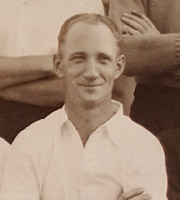
Tony McPhee
Reading career: 1938-49
149 appearances
104 goals
Claim to fame: Prolific goal-scorer who captained Reading’s London War Cup-winning side in 1941.
Scotsman (Magnus) Tony McPhee was one of our greatest goal scorers and, had his career not been interrupted by the war, he could undoubtedly be our record scorer by far. In fact if his war-time record of 212 goals is included in his record he is the most prolific scorer in the club’s history, with a total of 316 goals from 396 games in all competitions. Not surprisingly he was the top scorer in each of the 11 seasons he played for Reading. Late in his career he actually coached Ron Blackman who is still the club’s record League scorer.
Read more...
McPhee signed from Coventry in 1938 for almost £3,000 and scored 31 times in his first season. As a regular in war-time sides (he was in a listed occupation in the aircraft factory so did not serve in the forces) he often captained the side. He was indeed captain the day that Reading won the London War Cup in 1941. He was a traditional six foot tall number nine and retired at the age of 35 to take up coaching and management at Walsall.
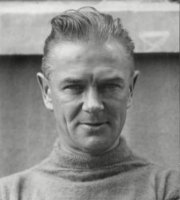
Joe Edelston
Reading career: 1939-47
Claim to fame: keeping the club going and cheerful throughout WWII
Joe was one of the first FA Staff Coaches and worked with the 1936 Great Britain Olympic squad. He was appointed manager of Reading in April 1939 having served Fulham in many capacities for 17 years. When war broke out in September 1939 the club were top of Division III (S). He steered the club through its first post-war season (1946-47) which included the club’s record 10-2 League victory over Crystal Palace.
Read more...
Joe is credited with boosting morale in the town during the dark days of WWII by ensuring Elm Park remained busy. He organised coaching sessions and fitness programmes for the locals and arranged for the great American heavyweight Joe Louis to appear in an exhibition bout on the pitch. Edelston managed the Reading side that won the London War Cup in 1941 beating Brentford 3-2 in the final at Stamford Bridge. This gave a boost to the town in dark times. Among the famous names who turned out for Reading in war-time were Matt Busby, Joe Mercer and Frank Swift and his own son Maurice (inducted to the Hall of Fame 2017).

Gordon Brice
Reading career: 1948-52
210 appearances
10 goals
Claim to fame: Dominant centre-half in a brilliant early 1950s team
Although Ted Drake’s Reading teams of the late 40s, early 50s, were known for their goal-scoring abilities, there was no shortage of top-class defenders either and Gordon Brice was the best of a very good bunch. An imposing centre half who was dominant in the air and on the ground, Gordon joined us from Wolves in March 1948 for a hefty £5,000.
Read more...
He soon established himself in the first team and from the start of the 1948-49 season to his transfer to Fulham in November 1952 for another sizeable fee he missed just two first team games (both of which were lost). Included in the period was a run of 148 consecutive first team appearances, a club record at the time. However, not all those games were in the number five shirt – remarkably he started 1950-51 as first choice centre forward, scoring three times in his first 10 games before Ron Blackman reclaimed his place in the attack.
With Gordon at the heart of the defence in the no.5 shirt Reading finished runners-up in Division Three South in 1949 and 1952 and third in 1951 – just missing out on promotion on each occasion and regularly playing in front of home crowds of over 20,000.
Gordon’s versatility did not end on the football pitch – while at Elm Park he appeared for Northamptonshire, taking 72 wickets for them in the County Championship in 25 games. In a match against the West Indies he had the ‘honour’ of being clean bowled by the legendary Sonny Ramadhin.
1950s
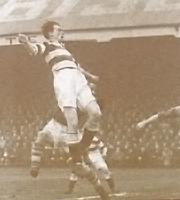
Ronnie Blackman
Reading career: 1947-54
240 appearances
167 goals
Claim to fame: Club record scorer for League goals in a season and in a career.
In 1950-51 his 35-goal League goal haul was increased by cup, friendly and reserve strikes to give him a remarkable 52 goal total while, the following season he was the first Reading player to top the division’s scorers with a club record 39 goals. In addition, that season saw him create another piece of club history when he scored in a friendly at Swindon that was the club’s first goal under floodlights.
Read more...
Both Portsmouth and Southampton failed to pick up on Cosham-born Ron Blackman but 93 goals in 67 games for Gosport brought him to Reading’s attention. Signed initially on a part-time basis in February 1947 Ron cost Reading just the statutory £10 signing on fee, along with a friendly at Gosport, a promise that was not fulfilled until 1979!
Having signed as a full professional six months later, Ron was coached by Reading’s veteran centre forward, Tony MacPhee, and under this prolific scorer Ron made great progress and in April 1948 he scored his first League goal in his third game. Even so, Ron had to wait until the following February to get a regular starting place, making the number nine shirt his own with a hat-trick on his return to the first team – the first of a club record 11 three-goal hauls or better that included two matches in which he scored five times. From then on Ron averaged well over a goal every other game to top our scorers’ lists for the next five seasons.
Ron had a powerful shot in both feet but it was his heading ability that most fans will remember him for. He combined a powerful leap with perfect timing to score 96 of his 197 with his head – even more remarkable when, in one of his first games for the club, he was criticised in the local press for a lack of heading ability! By the summer of 1954 Reading were struggling financially and so reluctantly agreed to sell their club captain and record scorer to Nottingham Forest for £6,600, a record fee that did little to placate Ron’s legions of fans. The move to Forest was not a success and although Ron fared better at Ipswich under their new manager, Alf Ramsey, a series of injuries meant that he never repeated his Elm Park form.
After a spell in non-League football, Ron left the game and worked for Reading GPO until his retirement. Ron was a tough competitor on the pitch but a perfect gentleman and his appearances at Elm Park and the Madejski Stadium were always greeted by warm and enthusiastic applause by Reading fans, many of whom had never seen him play. There was genuine sadness throughout the club when he died in February 2016 at the age of 90, leaving goal-scoring records that are unlikely to be surpassed.
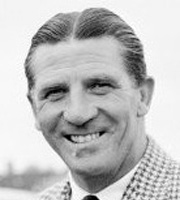
Ted Drake
Reading career: Manager 1947-52
Claim to fame: Reading’s first ‘modern’ manager who went on to Chelsea and Barcelona.
This legendary ex-England and Arsenal centre forward took his first break in league club management with Reading in 1947. Here he developed a youth system that produced Reading greats like Sylvan Anderton, Johnny Brooks, Maurice Evans, Stan Wicks and Jimmy Wheeler. His attractive, high-scoring side narrowly missed promotion from Division Three South on three occasions.
Read more...
Drake left to manage Chelsea in 1952 and in 1954-55 took them to their first Football League championship title and later had a spell as assistant manager at Barcelona. One of Reading’s best ever managers of a great team that didn’t quite make it. But he did have the rare distinction of managing Reading to victory over Arsenal – at cricket! Drake had been a first class cricketer before WWII playing occasionally for Hampshire.
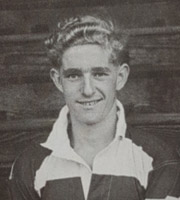
Johnny Brooks
Reading career: 1949-53
49 appearances
6 goals
Claim to fame: First Reading-born player to play for England.
Johnny may have only played 49 games in total for Reading but he was the first Reading born player to play for England. He played for local sides Mount Pleasant Youth Club, Coley Boys and Castle Street Institute before joining Reading ground staff in February 1949. Turning professional in April 1949 he was part of manager Ted Drake’s youth plan and made his first team debut in April 1950.
Read more...
His career at Reading was interrupted by National Service and he was only able to focus on football from 1952-53. His creative abilities at inside right, beautifully balanced and skilful, had many clubs watching him. Tottenham signed him in exchanged for Dennis Uphill, Harry Robshaw plus £ 3,000 in a deal worth £15,000. On the 14th November 1956 he made his England debut at Wembley against Wales in a game which England won. He played twice more for England, scored two goals and was again on the winning side.
In 1998 at the age of 66 he took part in the last competition played at Elm Park, an over 40s six-a-side where he showed that he still had an abundance of skills. He was still a twinkle-footed dribbler in his seventies when he played in STAR’s 2003 re-enactment of Reading’s first ever game back in 1872.
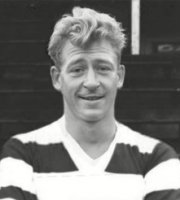
Jimmy Wheeler
Reading career: 1952-1968
Apps 452+1
168 goals
Claim to fame: a popular and prolific scorer and reserve team manager
Jimmy was born in Reading and played for Huntley & Palmers before joining Reading as an amateur in May 1952 and then signing professional in August 1952. Prior to joining Reading he had won the National Cup with Berkshire Boys. He started as a left winger but played across the forward line and became a prolific scorer. He scored 10 or more goals in all competitions for nine consecutive seasons from 1956-57 and was top scorer from 1957-58 through to 1960-61 when he scored 35 first team goals. Jimmy was a great favourite with the crowd and a real trier.
Read more...
He broke his leg in September 1964. In 1965-66 he only played two first team games but had great success in his new role as manager of the reserve side which went on to win the Football Combination Second Division title. The reserves attracted higher attendances than the first team at one point and Jimmy won the Player of the Season for 1965-66. Wheeler left Reading in 1968 to manage Bradford City and guided them to promotion from Division Four in his first season.
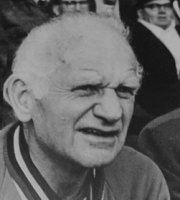
Jimmy Wallbanks
Reading career: 1953-1975
Apps: 58
1 goal
Claim to fame: Reading’s best-known trainer and probably the first physio to manage the club
Jimmy had a short League career with Reading as a centre-half, joining the club from Millwall in 1938 and continued to play during the war. He spent a few years assisting Bill Shankly at the start of his career at Carlisle before coming back to Reading where he spent the rest of his life. But he is best remembered as the long-serving trainer and physio, a position he first took up in 1953 and held until his testimonial match in 1975.
Read more...
He delighted fans with his unusual high-stepping run onto the pitch to treat injured players, a style that owed something to his days as a professional sprinter, and that curious bladder-like little bag he carried. When Jack Mansell was sacked in 1971 Jimmy enjoyed a 15 games spell as care-taker manager that included navigating past a difficult away tie at Blyth Spartans.
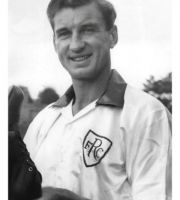
Stan Wicks
Reading career: 1946-1954
180 appearances
1 goal
Claim to fame: Local boy who stood tall, played strong and won honours
Stan was born in the town and played for Castle Street Institute before signing for Reading in May 1946 as an 18 year-old. He made his debut in the 1949-50 at full-back and enjoyed a largely unbroken run in the no.3 shirt for the next three seasons in which Reading came close to promotion. When Gordon Brice left Stan took on his role at centre-half but after half a season followed Gordon to west London. Stan moved to Chelsea for £13,300 in January 1954, to re-join his former Reading manager Ted Drake. He was a member of the Chelsea team that won the First Division Championship in 1954-55 under the captaincy of Roy Bentley.
Read more...
At 6ft 2ins and over 13 stone he was a relative giant at the time and a forceful defender. Besides a league champions medal he represented the FA side against Cambridge University, played for the Football Combination side and gained an England B cap in 1953. A bad knee injury ended his career in August 1957 at a point when he might possibly have gone further.
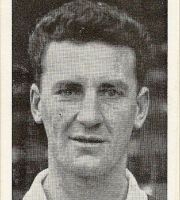
Ray Reeves
Reading career: 1947-1961
317 appearances
32 goals
Claim to fame: The club’s fiercest and best penalty-taker
Ray was born in Reading, joined the ground staff in 1947 and turned professional in 1949. He won caps for England at youth level but had to wait to November 1952 for his first team debut at the age of 21. Ray alternated between left-back and centre-half, was firmly established by 1956 and sometimes captained the team. He left Reading in 1961 for a brief cameo with Brentford but returned to the town in retirement.
Read more...
Like many players of that era he earned the nickname ‘Bomber’ for his cannon-ball shooting. Ray had a fearsome physical presence and a ferocious left foot. He scored many thunderbolts from long range as well as a club record 22 penalties in his long career. His tally of 32 was unusually high for a defender in those days.
Off the field Ray was a softly spoken and humorous gentle giant and continued to follow the club as a supporter until his death in 2007.
1960s
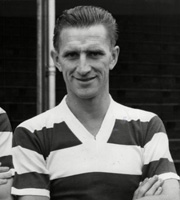
Johnny Walker
Reading career: 1957-1966
319 appearances
27 goals
Claim to fame: A football man through and through and a great character.
Johnny Walker signed for Reading on his 29th birthday – and still managed over 300 games over 8 seasons for the club such was his love of the game. He captained an entertaining side which generally finished near the top of the old Third Division and was a dead-eye penalty taker too. Despite never losing his Glasgow accent, and love of Rangers, Johnny settled in Reading and involved himself in local football and was a well-loved character full of wry humour and practical jokes.
Read more...
Walker’s professional career started with Wolves in 1947. Skilful and slightly built he made his mark in the First Division as a goal-scoring inside forward before joining Southampton in that role in 1952 for the then large fee of £12,000.
In 1957 he signed for Reading and, as the years went by and his pace diminished, he worked his way backwards from inside forward to wing half and then right full back where, on occasions, he partnered Gordon Neate. Many of his 27 goals for Reading were scored from the penalty spot, the cool head of a wily veteran coming to the fore. His party trick was to dance a jig on the spot and then speed past his baffled opponent. The nearest he came to any honours at the club was as a runner-up in the Southern Professional Floodlit Cup final in 1958.
After retiring from professional football at the age of 37 he assisted various local clubs including Wokingham and Tilehurst. For many years he worked for the Post Office in Reading and then at Theale Social Club. In retirement could often be spotted in Broad Street wearing a shirt with RFC embroidered on the breast – Rangers FC!
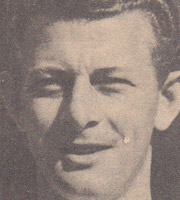
Gordon Neate
Reading career: 1956-2009
107 appearances
2 goals
Claim to fame: 53 years of loyal service to the club
Gordon Neate is one of Reading Football Club’s most loyal and popular figures, having served as player and groundsman for over half a century. Given the nickname ‘Fred’ by friend and colleague Maurice Evans, the local lad arrived as an apprentice at Elm Park at the age of 15 in 1956 after an impressive career in schoolboy football.
Read more...
Gordon played for the club’s minor teams before turning professional in March 1958 and made his first team debut away at Colchester in April 1959. His home league debut came on the final day of the season, when Reading thrashed Accrington Stanley 5-0.
The full-back was in and out of the side over the next seven years due to terrible luck with injuries, and was forced to hang up his boots in 1966 at the age of just 25. In his last playing season Gordon had some consolation when he picked up a Football Combination Division Two championship medal as part of the reserve team. Reading chairman Alf Smith then offered Gordon the post of groundsman and, after assisting Bill Smith briefly using the knowledge he’d gained working on the pitch during his time on the ground staff, he took on the task of tending the turf along with general ground maintenance. During his time as groundsman there was a competition to find out who had the hardest shot in the club. Gordon won it – beating the two goalkeepers into second and third place. All the forwards missed the target! Gordon liked a laugh, a chat and a friendly word with the fans – except when they got on his pitch.
Gordon’s long service and loyalty was recognized as he received a Canon League Loyalty Award in 1985 and a Football League Long Service Award in 1996. He followed the club to the Madejski Stadium in 1998 as groundsman before eventually retiring in 2009 at the age of 68, meaning that he had served Reading Football Club with distinction for a remarkable 53 years.
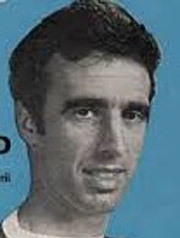
Dick Spiers
Reading career: 1956-69
492+2 apps appearances
4 goals
Claim to fame: Loyal one club man who once held the club’s league appearance record
Dick Spiers played for Cholsey United before joining Reading in 1955 originally as an amateur. Competition from other centre-halves and National Service disrupted his earlier career but from Christmas 1960 until September 1966 he missed only 6 games. He was a tall, lean, deceptively strong defender whose long neck aided his aerial battles.
Read more...
Spiers regularly captained Reading and went on to hold the club’s record for first team appearances, his last game coming in 1969. Ironically this was eventually beaten by a player he scouted for the club, Martin Hicks! He was rewarded with a star-studded testimonial match in 1970 in which he scored a rare goal.
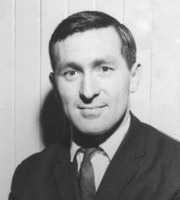
Denis Allen
Reading career: 1961-70
373+4apps appearances
95 goals
Claim to fame: Hugely versatile and popular player – and also a Malaya international
Denis, born in Dagenham, was spotted by Charlton Athletic when captaining a local team that included Bobby Moore. He did not make an impression at The Valley so moved onto Reading for a small fee in 1961and became one of the club’s all-time bargains. Denis played throughout the sixties, proving to be very versatile by playing every position from 4 to 11 and was also the stand-in goalkeeper.
Read more...
A very popular player, he was nicknamed “Daisy” by the fans. In his first season, 1961-62 Denis was Reading’s top League scorer as he was for the following two seasons. He also scored a hat trick in Reading’s first win the League Cup against Chester (4-2). Denis was converted into a scheming midfielder adept from dead-ball situations and then towards the end of his Reading career he played as a centre-half / sweeper. Denis was sold to Bournemouth but his popularity was demonstrated when over 12,000 turned up for his testimonial.
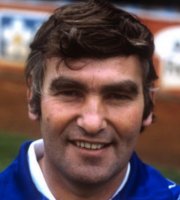
Maurice Evans
Reading career: 1953-66 and 1974-84
Apps: 459
16 goals
Claim to fame: A much-loved club man who did everything well and in good spirit
Maurice could be inducted for the 1950s or 1970s too! He was born in Reading and played for Didcot’s A team before joining Reading and turning professional in September 1953, making his debut in October 1955 at left half. From 1961-62 to 1963-64 he only missed 5 league games in total. His strong but fair play, good character and all-round effort made him a firm favourite with the fans. Towards the end of his career he was tried at full-back and made the last of his 459 appearances (16 goals) in October 1966. He was never booked or sent off.
Read more...
On leaving Reading Maurice (‘Mo’) worked as a coach at Andover and Shrewsbury before returning to the club as assistant manager in 1974. He was involved in Reading’s first promotion for 50 years in 1976, became manager in 1977 and guided Reading to the Division Four title in 1979 with an attractive, attacking, side. The years that followed were a financial struggle with the club up for sale and relegation in 1983 but it was a great shock when Maurice was sacked in 1984 with the club positioned in the promotion places (and eventually going up). Despite then becoming manager of Oxford United Maurice retained his honorary position as a vice-president of the Supporters’ Club.
Maurice returned for a third time, sadly all too briefly, in 2000 as Director of Football. He was an immensely popular and respected figure throughout the game. A plaque commemorating his life hangs outside the ticket office – ‘Player, Manager, Gentleman’ it reads.
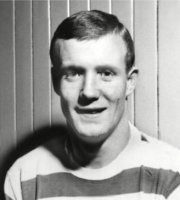
Colin Meldrum
Reading career: 1963-1969
Apps: 302+2
9 goals
Claim to fame: The first (and second) holder of the supporters’ Player of the Season trophy
Colin signed for Reading from Watford in April 1963 for £1,300 becoming one of manager Roy Bentley’s best signings. He was a virtual ever present from April 1963 to October 1969 mainly at left-back. Colin was Reading’s first Player of the Season in 1963-64 and retained the trophy the next season. He often captained Reading and also played at centre half and, in desperate moments, at centre-forward. Meldrum was one of our first overlapping full-backs as well as being a tough-tackling Scot who inspired team-mates by example. Colin made a total of 334 (4) first team appearances and scored 9 goals.
Read more...
He moved to Cambridge United where he gained promotion to the Football League in 1969-70 and scored their first ever league goal. After retiring he had a long career in the lower leagues as a manager / coach.
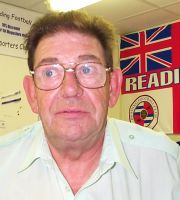
Mick Foster
Reading career: 1955-to date
Supporter
Claim to fame: Decades of hard work and strong support for both the supporters’ club and the football club
No Reading fan spent more time at Elm Park than Mick Foster who, in his five decades of watching the club at our old ground, watched virtually every first team and reserve game played there. But Mick didn’t just watch – as a member of the Supporters’ Club committee for that period, he would arrive two hours before kick-off and leave about an hour after the final whistle. Mick’s match days were spent first setting up and then running the club shops, selling old programmes and souvenirs with a ‘brusque’ customer service style all of his own, raising valuable funds at a time when the few hundred pounds raised were vital to the club’s survival.
Read more...
More importantly, Mick was instrumental in launching Supporters’ Club coaches to away games, a service that still flourishes to this day and – at times – hired special trains for away trips. He also spent many hours on a voluntary basis helping football club secretary Fred May during the impoverished days of the 1960s.
Somehow Mick gathered an astonishing array of senior contacts in the game, most notably a good friendship with Matt Busby.
Mick’s booming voice was a feature of games in the early Sixties and he is thought to have been the instigator of the legendary ‘Your Rs’ shout (which lives on as URRRZ). A Life Member of STAR, Mick now sufferers from mobility problems but remains a season ticket holder and still attends as many games as he can.
1970s
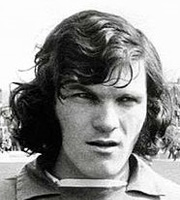
Steve Death
Reading career: 1969-82
537 appearances
0 goals
Claim to fame: One of Reading’s greatest goalkeepers and the holder of several records.
One of the most recognisable characters of the Reading teams of the1970s Death originally signed on loan from West Ham in November 1969. The move was made permanent in 1970 for a club record fee of £20,000 and Steve went on to make 471 league appearances and 537 total appearances for the club and only bettered by Martin Hicks.
Read more...
Death shared England Schoolboys duties with Peter Shilton but only made one First Division appearance for West Ham. At just 5’8”, he had to make up for his lack of inches with agility and bravery and was capable of some astonishing saves.
His kicking wasn’t great, his attention sometimes wandered and his attitude to training wasn’t flawless but he was nevertheless much loved by Reading fans as he played his part in the club’s promotions from Division Four in 1976 and 1979.
At the end of the latter campaign he set a league record of 1,074 minutes without conceding a goal, extended briefly to 1,103 minutes the following season before being beaten by an own goal whilst he was semi-conscious. He won the Reading Player of the Year on a record four occasions and was also chosen for two PFA awards in 1974 and 1979.
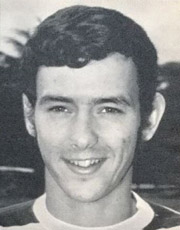
Gordon Cumming
Reading career: 1969-77
311+2 appearances
62 goals
Claim to fame: Tricky goal-scoring winger who captained our first promotion side in 50 years.
After a highly successful start as a schoolboy and youth footballer Scottish-born Cumming signed for Reading from Arsenal in December 1969. As a slightly-built, skilful right winger Gordon made an immediate impact in Jack Mansell’s brilliant ‘one touch’ team of early 1970. Cumming was twice top scorer (a cool penalty-taker) and Player of the Season in 1972.
Read more...
In his late 20s he took up a midfield berth, and the club captaincy, and alongside the experienced Eamon Dunphy, schemed Reading to the club’s first promotion in 50 years in 1976 with grit, energy and good short passing. Years toiling in Division Four took its toll on Cumming’s small frame and he retired from football in 1978. He continues to live locally and support the club from the stands.
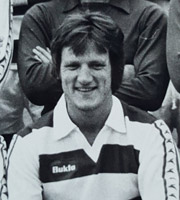
Steve Hetzke
Reading career: 1971-82
293+10 appearances
33 goals
Claim to fame: Once our youngest ever player who went on to win two promotions.
Steve joined Reading from Hungerford Town as an apprentice in June 1971 and signed professional in June 1973. He became Reading’s youngest ever League player against Darlington in December 1971 at the age of 16 years and 193 days. He played regularly in the centre of the defence but competition for places meant that Steve did not play more than half of the games each season until 1978-79.
Read more...
That season Steve moved up to a striker’s role starting 42 League games and scoring 9 goals as Reading became Champions of Division Four. The next season Steve moved back into defence and then captained the club in 1981-82. In 1982 he left Reading and joined Blackpool, the first of several other clubs he played for before retiring.
Understandably nicknamed ‘Big ‘Un’ Steve was tall and strong in the air, with a decent touch on the ground and a powerful shot. Since retirement Steve has worked for the FA and PL in the coaching, youth development and technical domains and is now an Academy mentor at Swansea City.
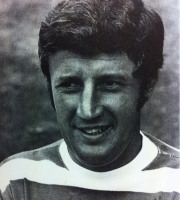
Bobby Williams
Reading career: 1969-1971
Apps: 67+5
22 goals
Claim to fame: A Bristolian who fell in love with the club and helped it in many ways
Bobby joined Reading in 1969 and served the club as a player, a coach and as a scout, a role that he has performed until very recently. He played for both Bristol clubs and Rotherham (under Jack Mansell). Reunited with Mansell at Reading Bobby played a key left-wing role in the hugely entertaining team of 1969-70, scoring 16 goals, often ghosting in at the far post – hence his nickname ‘The Shadow’. The following season began brightly with Williams captaining the team against Manchester U in the Watney Cup but was more of a struggle for Bobby, now aged 30, and ended in relegation and with him getting a free transfer. He played 67 times and scored 22 goals.
Read more...
Three years later he returned as reserve manager and then youth team coach, helping bring through such talents as Ady Williams, Neil Webb and Lawrie Sanchez. He has also served both Reading Football Supporters’ Club and its successor STAR loyally in the role of Vice-President and is still involved in the life of the club.
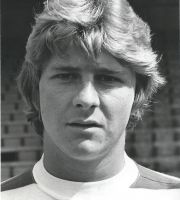
Gary Peters
Reading career: 1975-1979 and 1985-1988
277+17 appearances
12 goals
Claim to fame: Won promotion three times in very different Reading teams
Gary joined Reading from Guilford City in May 1975 for £1,000 at the age of 20. He was a tall, strong, hard-running and often attacking full-back. In his debut season he played 30 times at right back as Reading finished third and secured promotion from the 4th Division in 1975-76. Then in 1978-79 he was part of that record-breaking (1103 minutes without conceding) defence that won the 4th Division title and was also picked for the PFA Team of the Year for the Division. On the strength of these performances Gary joined Fulham for £ 40,000 in 1979.
Read more...
He won promotion with both Fulham and Wimbledon (twice) before re-joining Reading in 1985, essentially as a squad player. However, he was almost ever-present at right-back, then centre-half, as Reading clinched the 3rd Division title in 1985-86. One of his final appearances was a substitute near the end of Reading’s Simod Cup victory at Wembley in 1988.
He then re-joined Fulham. After retiring he gained another promotion as manager of Preston NE in 1996, where he signed David Beckham on loan, and later managed Exeter and Shrewsbury.
![mike_kearney[1] mike_kearney[1]](https://star-reading.org/wp-content/uploads/2021/03/mike_kearney1-167x200.jpg)
Mike Kearney
Reading career: 1978-1982 and 1990-2018
157+11 appearances
45 goals
Claim to fame: Versatility and dedication on and off the pitch
Few men can claim to have served the club in as many roles as Glasgow-born Mike Kearney. The legendary Maurice Evans signed him three times. The first was for Shrewsbury Town where he made his debut in February 1973. He was switched from centre forward to centre half as Shrewsbury won promotion to the Third Division. In March 1977 he moved to Chester for £8,000 and then re-joined Maurice, now at Reading, for £10,000 as a forward in February 1978. Reading won the Fourth Division title in his first full season at the club (1978-79). After finishing as the club’s top scorer in 1979-80 with 16 goals, Mike was sold back to Chester for £ 50,000, their then record fee. This did not go well and he returned to Reading in October 1980. He played as a tall, strong forward, in a deeper role and also in defence. He broke a bone in his foot in December 1982 and this eventually forced his retirement from League football, although he later played for Marlow and Basingstoke Town.
Read more...
In 1990 he returned to Elm Park once more to run the Royals Rendezvous social club on Tilehurst Road with his wife Grace, for a hospitable and enjoyable eight years. When the Rendezvous closed and the club moved to the Madejski Stadium Mike then became the first Promotions Manager. Later still he took up a position as facilities manager at the new Hogwood training ground.
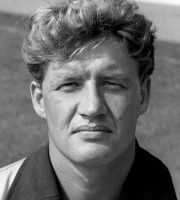
Mark White
Reading career: 1977-1988
303+17 appearances
13 goals
Claim to fame: The last Division Four (and promotion-winning goal) scored at Elm Park
Mark came to Reading as an 18 year-old trialist from Sheffield United in 1976. He made his debut in 1977 and made the no.3 shirt his own for the next few seasons. An ever-present as we won the Division Four title in 1979, setting the Football League record for most minutes without conceding a goal, Mark was a cultured and skilful left-back. In 1984 he scored a delightful goal from a free-kick to clinch promotion again in our last home game ever in Division Four.
Read more...
The combination of his skills and tackling led Ian Branfoot to convert him into a midfield player and in 1985 White played in all 13 consecutive wins from the start of the season – a still-standing league record. Thereafter he was again dogged by serious injuries and appeared only sporadically for us in Division Two before retiring in 1988.
His experience of many and serious injuries and long days in recovery may have influenced his post-retirement choice of career as he became a chartered physiotherapist, often working locally in Reading.
1980s
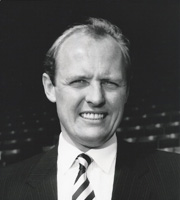
Roger Smee
Reading career: 1967-70 and 1973-74
62+4 appearances
17 goals
Claim to fame: Former player who saved and re-vitalised the club in its hour of need.
When Reading FC was threatened with extinction in the spring of 1983 it was former centre-forward Roger Smee who stepped up to the plate and saved the club from a ‘merger’ on most unfavourable terms with Robert Maxwell’s Oxford United. He was just 34 years old and less than 10 years away from the end of an injury-ravaged playing career. Under his chairmanship Reading achieved two promotions, the highest league placing for 60 years and victory at Wembley.
Read more...
Reading-born Smee did his football apprentice-ship at Chelsea before joining Reading in January 1967 and scoring on his league debut. As a bustling, blond centre forward he made an immediate impact with 9 goals in 15 matches (only one defeat) as Reading narrowly missed promotion in 1967. But injuries thereafter kept him in, and mostly out, of the team with his last appearance coming in November 1969 as Dick Habbin (another successful businessman in later life) took his shirt. He dropped down into non-league football with Hillingdon and Hereford and took the then unusual step of playing abroad with KV Ostend in Belgium. In October 1973 Smee had one last go at league football with Charlie Hurley’s goal-starved Biscuitmen but it didn’t work and this time he was replaced by Robin Friday.
Roger Smee trained for life outside football as a quantity surveyor and estate agent, soon forming his own Reading-based property company, Rockfort, which grew in strength in the late 1970s and early 1980s. Reading struggled terribly in 1982-83. The directors put the club up for sale and gates were sometimes below 2,000. In March 1983 it was announced that Robert Maxwell, the Oxford U chairman, would acquire the majority shareholding in Reading and merge the two clubs. Smee, and rebel Reading director Roy Tranter, led the successful fightback and by July 1983 he was in a position to become chairman of the club.
As a relatively young chairman Roger Smee was full of reforming and commercially-minded ideas in comparison with the moribund regime that preceded him. Out went the hooped shirts, Maurice Evans the respected manager (an unpopular decision) and the elms badge. In came plans to move the club from Elm Park to Smallmead, Ian Branfoot, the Royals Rendezvous bar, Trevor Senior, trophies, big transfers, records and promotions. It all ended in tears as the financial recession of late 1990 emptied Smee’s pockets and the club had to be rescued again, this time by John Madejski. But Smee’s six years not only saved the club but also revitalised its spirit with promotion from Division Four (1984), 13 wins from the start of the season (1985), promotion from Division Two (1986), highest-ever league placing (1987) and the Simod Cup victory at Wembley (1988).
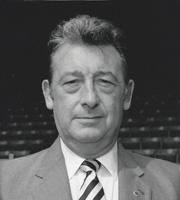
Roy Tranter
Reading career: Director 1983 and later President of RFSC / STAR
Claim to fame: Rebel director who played a key role in foiling Maxwell’s merger plan.
Roy was Reading born and a life-long supporter. He became a successful businessman in in the town after a long career with Reading Police. In 1983 Roy was a director on the Reading FC board under chairman Frank Waller. After Waller’s announcement that Reading and Oxford United were to merge Tranter played a leading dissident role from within the board to foil media mogul and United chairman Robert Maxwell in his plans.
Read more...
Tranter successfully applied for a series of injunctions that prevented the sale of shares and the creation of new shares thus creating valuable breathing space for Roger Smee to step in as the new chairman committed to keeping football in Reading. Tranter’s actions went some considerable way to saving the club.
He remained a friend to the club until his death in 2009 and accepted the honorary position of President of the Supporters’ Club, then of STAR in 2002. He is commemorated with a blue plaque outside the ticket office.
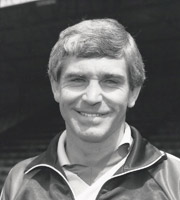
Ian Branfoot
Reading career: Manager 1984-89
Claim to fame: Two promotions, the Simod Cup and 13 wins from the start of the season.
Geordie-born Branfoot played for Sheffield Wednesday, Doncaster and Lincoln. Originally appointed as manager Maurice Evans’ assistant in July 1983, Ian was appointed first-team boss in January 1984. Branfoot sealed promotion from Division Four that season.
Read more...
Two years later his team’s direct, hard-working and all-action style led to a (still standing) league record of 13 consecutive wins from the start of the 1985-86 season and 62 points before New Year’s Day. Reading stormed to the Third Division title in 1986 to return to Division Two for the first time in 55 years and then reached the highest ever (at the time) league finish of 13th in 1987. Ian also led the club to its first Wembley appearance and a 4-1 Simod Cup triumph over Luton Town in 1988.
Branfoot was the first of the young “tracksuit” managers for the club. He employed a very simple 4-4-2 ethos at the club very effectively for his first five seasons but after relegation from Division Two in 1988 he was unable to repeat his success and left the club in October 1989. He later managed Southampton and coached at Crystal Palace.
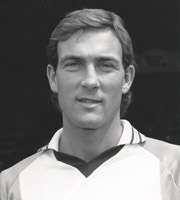
Martin Hicks
Reading career: 1978-91
601+2 appearances
26 goals
Claim to fame: Three promotions, the Simod Cup and the club appearance record.
Martin Hicks still holds the club record of 499+1 league appearances, 601+2 total appearances. He signed from Charlton in February 1978 for £3,000 having once been rejected by Reading after a trial. Over the next 13 seasons Martin was the club’s first choice centre-half and in his first full season in 1978-79 won a Fourth Division Championship medal.
Read more...
He won promotion again to the Third Division in 1983-84 and then captained the team to a Third Division Championship in 1985-86 and a Simod Cup triumph at Wembley in 1988. He was also in the Reading record-breaking teams that went 11 consecutive league games without conceding a goal in 1979 and had a 13 match winning start in 1985-86.
At 6ft 2ins he was dominant centre-half with a mighty clearance and also weighed in with headed goals from set pieces and thunderous free kicks. One of the more gentlemanly centre-halves of the era he took his fair share of knocks for Reading including two broken jaws. He finished his playing career at Birmingham City where he won promotion again. International honours came very late as a member of the England over-35s side for whom he once marked Paolo Rossi and Socrates in the Pele Cup!
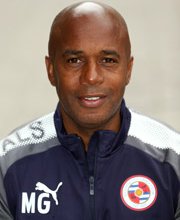
Michael Gilkes
Reading career: 1984-97
430+56 appearances
52 goals
Coach
Claim to fame: Much-loved super-fast winger who won promotion twice.
Michael Gilkes was one of the most popular players ever to wear the hoops, ‘Gilkesy’ arrived on a free from Leicester in July 1984. His searing pace on the left wing quickly made him a fans’ favourite, particularly with his second half dashes in front of the South Bank. He played a few times in the title winning 1985-86 side. Inconsistency led to boss Ian Branfoot switching him to left back in 1987-88 and after that he was virtually an ever-present in the team.
Read more...
After very brief loan spells with Chelsea and Southampton, Michael’s Reading career was revitalized under Mark McGhee as either a left winger or left back and he helped the club to the Division Two title in 1993-94 and the Division One play-off final in 1994-95. He was probably the fastest player ever seen at Reading to that point and made his mark in a speed competition at a national level. In 12 years playing he could outstrip nearly every full back that came his way. He was sold to Wolves for £150,000 in 1997 and later played for Millwall. Gilkes won 5 international caps for Barbados. He has since been with the club as Under 18 Academy coach and ‘Ambassador’. As U18 coach he helped the club to a record FA Youth Cup semi-Final position in 2013-14 and he is now (2018) an assistant manager at the club.
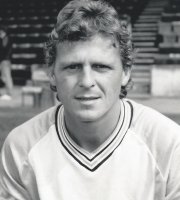
Stuart Beavon
Reading career: 1980-1990
Apps: 460+21
55 goals
Claim to fame: Skilful midfielder who scored vital penalties.
Stuart joined Reading in 1980 from Spurs and was a permanent fixture in the Reading team for the entire 1980s, mainly in the number 4 shirt. He was a cultured midfielder and dead-ball expert, scoring 55 goals in 460 appearances and creating countless more with his accurate free kicks and corner kicks.
Read more...
Beavon was the creator of many goals for the free-scoring promotion sides of 1984 (3rd in Division Four) and 1986 (Division Three champions) and converted the penalty at Wembley which put Reading on course to our famous Simod Cup win over Luton. He also netted a brace at Chesterfield the following season to prevent the club from a disastrous second relegation in two years.
Football was very much in Stuart’s blood. His father played for Oxford and his son for Wycombe. In retirement Stuart continued to live in the Reading area.
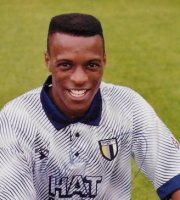
Steve Richardson
Reading career: 1982-1993
Apps: 449+8
3 goals
Claim to fame: Scored the goal that gave Reading the (then) highest League table finish
A tough tackling, fast, left back Steve made the number three shirt his own over an eleven-year career with the club, thanks to his consistency and enthusiasm. He signed from Southampton in 1982 and was a virtual ever present in the promotion seasons of 1984 and 1986 (the record-breaking 13 wins from the start of the season team) and the Simod Cup triumph in 1988. Despite standing only 5’5” he had an amazing leap and was a formidable opponent both on the ground and in the air.
Read more...
Steve only managed 3 goals in 449 appearances for Reading but memorably did score the goal away at Ipswich in 1987 that led Reading to our then highest ever league placing. He twice won the Supporters Player of the Season trophy and in 1984 was in the PFA 4th Division team of the year. Steve left the club in May 1993 and continued for local non-league clubs including, notably, Basingstoke Town.
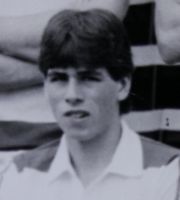
Neil Webb
Reading career: 1979-1982
72+9 appearances
22 goals
Claim to fame: Youngest ever player and goal-scorer who went on to a glittering career
Son of Dougie Webb, a Reading forward of the 1960s, locally born Neil was the youngest player to be selected, second youngest to play and youngest ever goal scorer. He was capped 10 times for England Youth and scored a hat-trick against Egypt in the 1981 World Youth Cup, so his talent was obvious at an early age. Neil was a highly skilful, attacking midfielder and the best Reading-born youth product in many years. He started in the no.8 shirt and worked his way back to no.4. In 1981-82 he was top scorer with 15 despite his midfield berth. It was a pity that Neil only played in an average and financially strapped Third Division side at Elm Park.
Read more...
By 1982 he was Reading’s youngest top scorer but that summer he moved to Portsmouth for a record fee of £87,500. He won the Third Division championship there before moving to Nottingham Forest in June 1985, for which Reading earned another £80,000. In June 1989 he moved on to Manchester U for an even larger fee of £1.5m. At Forest he won the League Cup and at United the FA Cup in 1990, the Cup-winners Cup in 1991 and the League Cup again in 1992.
He became the 1000th England player on his debut in 1987 and scored on his first start. In total he made 26 appearances for his country, scoring four goals, and was a member of the 1990 World Cup squad which finished fourth. Unfortunately he sustained a serious injury on England duty and was never quite the same player again. Nevertheless his career continued with further spells at Forest, Grimsby and Aldershot and approached 500 senior games in total. In retirement he returned to Reading and worked in various media roles.
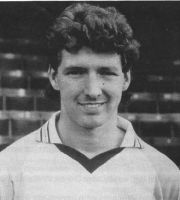
Trevor Senior
Reading career: 1983-1988, 1989-1992
351+11 appearances
190 goals
Claim to fame: Reading’s record goal-scorer of all time across all competitions
Trevor joined Reading from Portsmouth in July 1983 for £35,000 and was an immediate success with hat-tricks in his first two games at Elm Park. In the first of these versus Stockport County he scored the three in a club record time of 4 mins 17 seconds. He ended the 1983-84 season with a club record of 41 goals to become the first Reading player ever to be the League’s top marksman. He won a PFA Divisional award, an Adidas Golden Boot, a Rothman’s Yearbook award and promotion from the Fourth Division. In 1984-85 he had a run of nine consecutive scoring games, another club record. The following season Trevor scored 27 goals when Reading ran away with the Third Division title in 1985-86, starting with 13 consecutive wins.
Read more...
Tall and leggy, Senior was a born goal-scorer capable of netting with any part of his body, mixing the magnificent strike with either foot with the mundane tap-in.
In July 1987, after helping Reading stabilise in Division Two, he was transferred to Watford for a then record fee for Reading of £325,000. This transfer didn’t turn out well for either club. Trevor only managed one league goal for Watford and Reading, without his goals, were relegated. He then joined Middlesbrough in March 1988 and helped them win promotion to Division One via the play offs.
He did not settle in the north-east and he returned to Reading in October 1988, for a fee of £150,000. Yet again he was then top goal scorer for the next three seasons before being released in July 1992. Altogether he scored a club record of 190 goals in all senior competitions – but the only game he played in the famous blue and white hoops was a pre-season friendly in 1983!
Trevor remains one of the most popular players in the club’s history and not just for his goals. He had a real feeling for the club and its fans – and preserving his own records, one of which, very arguably, is the club’s best ever goalkeeper, statistically speaking! In four emergency appearances between the sticks, including his farewell appearance, he was unbeaten between the sticks. After Reading Trevor played and then managed in non-football.
1990s
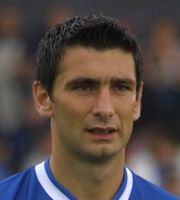
Ady Williams
Reading career: 1988-96, 2000-04
377+8 appearances
22 goals
Claim to fame: Mr Everywhere – he played at all levels and in every shirt.
Besides a fine and long career and a big personality Ady Williams grabbed more than his fair share of unusual records. He was the first player to play all the way through from schoolboy level to full international whilst on Reading’s books. He wore every number shirt from 1 to 14 in his Reading career, plus a very, very, brief spell as joint-manager and he netted the Royals’ 5,000 League goal. He is currently (2016) still with us as a leading football pundit on BBC Radio Berkshire.
Read more...
Reading-born Williams came through the Centre for Excellence, the precursor of the Academy, as a right winger before switching to full-back, aged 17. It took until the 1991-92 season for him to become established in the first team playing alongside Keith McPherson at centre back. Under Mark McGhee’s management Reading – and Williams – improved considerably and the Division Two title was won in 1994.
The following season Reading challenged strongly for promotion to the Premier League – even after McGhee departed mid-season, leaving the 24 year-old Williams one of four joint-managers appointed by John Madejski. Ady quickly renounced any claims on the boss’s chair and continued with his forceful and stylish centre-half play, often bringing the ball out into midfield. At 6 foot 2 he was strong in the air as well. By now, and by virtue of his father’s place of birth Ady was a Welsh international.
In the summer of 1996 Williams re-joined McGhee who was now managing Wolves. Injuries in the mid-part of his career restricted Ady to just 36 appearances at Molineux and in the spring of 2000 he came back to Reading on loan. It was a successful spell under Alan Pardew’s invigorating management and so in the summer he signed for a third time for Reading and won promotion again from Division Two in 2002.
In 2004 Ady left Reading for a successful spell with Coventry before seeing out his career at Millwall and Swindon, retiring in 2009. In total he made nearly 500 appearances for all clubs and earned 12 international caps. After trying his luck in management, mainly at a non-league level, Williams then focused on a career in media where his energy and perception paid dividends.
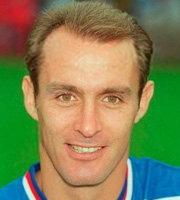
Jimmy Quinn
Reading career: 1992-97, Player-Manager
216 appearances
94 goals
Claim to fame: Scorer of beautiful goals and lots of them.
Signed by Mark McGhee from Bournemouth in July 1992 for a mere ₤55,000, the 32-year old Jimmy proved to be one of the club’s best-ever signings. Top-scoring with 23 goals in his first season, the following season Jimmy formed a deadly partnership with Stuart Lovell and scored 40 of their 62-goal partnership as Reading won the Division Two Championship. He was the leading League scorer that season.
Read more...
An astute, intelligent No. 9 with two good feet and brilliant in the air, Jimmy scored some memorable goals for the club, notably the over-the-shoulder volley against Wolves in April 1996 that secured Reading’s Division One survival. He was a particularly stylish and technically gifted player.
Quinn became joint player-manager with Mick Gooding after Mark McGhee’s sudden departure in December 1994 and this appointment lasted until the end of 1996-97 season. He then had spells with Swindon and Peterborough. Jimmy was a regular Northern Irish international and Reading’s most capped player for several years, until Kevin Doyle beat his record of 17 international caps whilst with the club.

John Madejski
Chairman 1990-2012: co-chairman 2012-17
Claim to fame: Completely transformed a third tier club and build a new stadium.
John Madejski (later Sir John) is one of several figures to rescue the club when it has been at death’s door but none has had such a lasting and dramatic impact. His longevity as the figurehead of the club even surpasses the first President, James Simonds (1871-95).
Read more...
The club was in desperate financial straits when Madejski became the major shareholder in November 1990. Within in a few years he came to own 95% of the shares and took the crucial decision to relocate the club from Elm Park, a ground which was no longer suitable for the modern age. In 1998 Reading FC moved to the stadium that bears his name, down by Junction 11 of the M4. With 24,000 seats and ancillary hotel, hospitality and conference facilities the stadium opened up the club to new audiences.
It took until 2002 for Reading to regain a place in the second tier but that status has been retained, or improved upon, ever since, the longest period in the club’s history at that level. Together that status and the stadium have enabled the club to grow attendances and reputation at a sustained level that has transformed the club. All this began in the 1990s with the first of several inspired managerial appointments in Mark McGhee (others later were Alan Pardew, Steve Coppell and Brian McDermott). McGhee’s side took the third tier title in style in 1993-94 while off-the-field it was the beginning of a family feel about the club and Madejski’s famously cautious financial management, all labelled ‘the Reading way’.
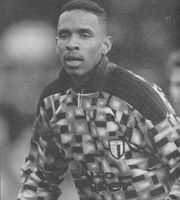
Shaka Hislop
Reading career: 1992-95, Goalkeeper
126 appearances
Claim to fame: Arguably Reading’s best ever keeper and a crowd favourite.
Shaka Hislop proved to be one of Reading’s best ever goalkeepers in the short period he was with the club. He took the often lurid and multi-coloured jersey permanently from Steve Francis at the start of the 1993-94 season and played 110 consecutive matches, winning a Division Two champions medal and finishing as a Division One runner-up before moving to Newcastle for £1,565,000.
Read more...
Though born in London Shaka came from the unlikely source of US college football, where he had been a student of aeronautical engineering. He made his Reading debut in September 1992. Tall, long and loose-limbed, agile and cool under pressure Hislop was an instant hit with the Reading fans who frequently sang “Shaka, Shaka, what’s the score?” In his two seasons as the first choice keeper he let in less than a goal a game and was a vital component in Mark McGhee’s attractive team that won Division Two in style in 1993-94. The following season Shaka played even better at a higher level making scores of stupendous saves that kept Reading in games they might otherwise have lost. The Elm Park men finished second in the second tier of English football, the highest position the club had ever reached at that point in time. Unfortunately Reading lost a dramatic play-off final to Bolton at Wembley in what was Hislop’s last game for the club.
After a period with Newcastle Shaka went on to play for West Ham and Portsmouth. Towards the end of his career he represented Trinidad and Tobago in the World Cup Finals of 2006 and later became a well-known broadcaster for ESPN.
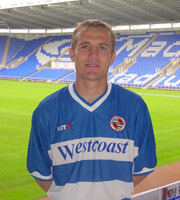
Phil Parkinson
Reading career: 1992-2002
392+23 appearances
23 goals
Claim to fame: Captain and the heart of the team in good times and not-so-good.
Phil Parkinson joined Reading in 1992 and spent 10 years at the club. He was named player of the season two years in a row (1997–98 and 1998–99) and was also a key member of the 1993–94 Division Two championship-winning team. He captained the team to promotion from the third tier in 2001–02. In a vote to compile the supporters best-ever XI, Parkinson was voted the best central midfielder for his hard-tackling, never –say-die style.
Read more...
Following retirement from playing in 2002, Parky went into management. He has enjoyed success in winning promotion with Colchester in 2005-06 and with Bradford City in 2012-13.He is the first ever manager to take an English fourth-tier league club (Bradford City) to the final of a major cup competition at Wembley, where they finished runners-up in the Football League Cup in 2013 and took City to the FA Cup Quarter Finals in 2015. He is currently manager of Bolton.
Phil Parkinson wore his heart on his sleeve and was fully committed to Reading through years both thick and thin. Rarely has the club had another tackler and captain like him. He was the last but one player to be awarded a testimonial match by the club and 20,000 turned up on a rain-soaked evening.
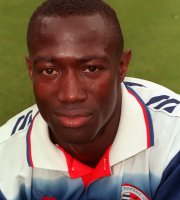
Keith McPherson
Reading career: 1990-1999
Apps: 307+10
8 goals
Claim to fame: Captain of the Division Two title-winning side of 1993-94
Keith was a product of West Ham’s famous youth academy. He joined Reading from Northampton in 1990 and was a regular choice at centre-back for the next nine years. Keith was the Reading captain under three different managers: Ian Porterfield, Mark McGhee and Jimmy Quinn/Mick Gooding.
Read more...
He was not especially tall for a centre-back but was quick and tough as teak and adapted to many different playing styles and defensive partnerships. Keith skippered the club to the Division Two championship in 1994 and so nearly into the Premier League the following season.
In total he played 307+10 games for Reading and scored 8 goals. From Reading he joined Brighton where he was also appointed captain.
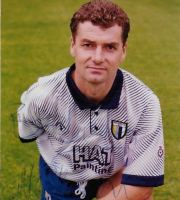
Mick Gooding
Reading career: 1989-1997
Apps: 356+12
30 goals
Claim to fame: Great midfield all-rounder who led Reading to play-off final
Mick was already a well-travelled 30 year-old Geordie when he signed for Reading in 1989 from Wolves but he was fit enough to still be playing League football at 40 (at Southend) with a total of 700 appearances under his belt. He was both tough and skilful in Reading’s midfield and a key component of Mark McGhee’s side that won the Division Two title in 1994 and just missed the Premier League in 1995.
Read more...
When McGhee suddenly left for Leicester in December 1994 Mick and Jimmy Quinn took on the unusual roles of joint-player-managers and guided Reading to the club’s first, and most tragic, play-off final defeat at Wembley against Bolton. With some outstanding talents sold off, the next two seasons were a struggle and at the end of 1996-97 Mick and Jimmy left the club – but still safely in the second tier.
To play 360 times having joined the club at the age of the 30 is a remarkable tribute to Mick’s drive and fitness. He has continued to live in the area and for many years been the co-commentator on BBC Radio Berkshire.
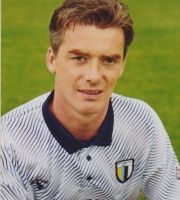
Kevin Dillon
Reading career: 1991-1994 and 1996-2004
118+1 Appearances
5 goals
Claim to fame: A truly class act in a promotion-winning midfield
Kevin was moving towards the veteran stage when he joined Reading in 1991 at the age of 31. Sir Alf Ramsey had given him his debut at Birmingham in 1977 and his early promise led to an England U21 cap and moves to Portsmouth and Newcastle. At Elm Park under Mark McGhee he was very much the midfield play-maker, controlling the tempo of the game and striking deep passes for Quinn, Lovell and Gilkes. Dillon was one of those players worth watching for style as well as content and the Division Two (third tier) title-winners of 1994 were one of the most popular and entertaining sides ever seen at Elm Park. Kevin left the club at the end of that season and saw out his playing career at Stevenage and Yeovil.
Read more...
He then returned to Reading in a youth coaching role and over the next decade held a variety of positions including assistant manager to Alan Pardew in the 2002 promotion season and to Steve Coppell in the 2006 promotion season and a spell as caretaker manager between the two. Later he had a successful stint as Aldershot manager and appeared as co-commentator on BBC Radio Berkshire from time to time before re-locating to his native Sunderland.
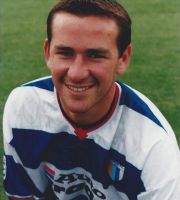
Stuart Lovell
Reading career: 1988-1998
204+62 Appearances
67 goals
Claim to fame: A moment best overlooked, to be fair!
Though an Australian by birth Lovell was always regarded as a local boy who grew up in the town and joined the club as a YTS trainee in 1988. It was at this point, under the tutelage of Bobby Williams, that he somehow acquired the nickname Archie which stuck with them thereafter.
Read more...
A clever forward with an accurate shot and an eye for goal Archie made his full debut in December 1990, Sir John Madejski’s first game as chairman and scored the game’s only goal. He gradually cemented his place as support striker in Mark McGhee’s improving side and in the Division Two title-winning season of 1993-94 missed only one game. His goal return in all competitions was 22. Archie adapted quickly to the higher level and scored 14 in all competitions as Reading finished runners-up in Division One and entered the play-offs for the first team. He scored twice in the semi-final victory over Tranmere and was by now playing alongside Lee Nogan rather than Jimmy Quinn who had been the established penalty taker. With Reading 2-0 up in the play-off final against Bolton Archie’s penalty, which could have made the game safe, was saved and tragically the Wanderers came back to win 4-3 in extra-time.
The miss didn’t affect the likeable Lovell’s popularity with the Elm Park crowd and in the spring on 1997 he was involved in another dramatic moment with a far more positive ending. Trailing to the only goal in a needle match with McGhee’s Wolves Archie popped up twice with goals in injury time to secure a memorable victory. He left the club at the end of the 1997-98, thus just missing out on playing at the Madejski Stadium, and joined Hibernian.
At Easter Road he won promotion with Hibs, and two caps for Australia, and then captained Livingston to their first major honour in the Scottish League Cup of 2004. In retirement in Scotland he has worked for the PFA and in various media roles.
2000s
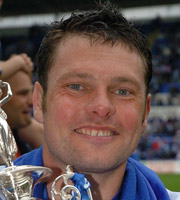
Graeme Murty
Reading career: 1998-2009
321+12 appearances
2 goals
Claim to fame: Captain of the “106” team and all-round good guy.
Despite an injury-blighted start to his Reading career Graeme Murty persevered to become one of the all-time fans’ favourites. He captained the club from right back in the years 2005-08 as Reading won promotion to the Premier League and then achieved the club’s highest ever league finish in 2007. In his time at Reading he was an active charity fund-raiser and ambassador for the club – as well as a notoriously infrequent goal-scorer!
Read more...
Murty’s magic moment came in the final match of the 2005-06 season when Reading were awarded a late penalty. A goal and Reading would set a new Football League record for the most points won in a season. Murty’s only other goal, a screamer to be fair, had come five years earlier. With the chant of “he knows he is, he’s sure he is, he’s M U R T Y” ringing around the capacity crowd in the Madejski stadium stepped up to score amid wild celebrations.
He joined Reading in 1998, as a Tommy Burns signing, from York City where he had often played on the right wing. Playing in a pre-season friendly in July 1998 gave him the distinction of being the last Reading player to play at both Elm Park and the Madejski Stadium. Long spells out with injury restricted him to just 40 starts in his first three seasons. Thereafter he had five seasons as the regular right back, tough and tenacious in defence and overlapping to good purpose in attack. In the first of those seasons Reading won promotion back to the second tier (2002) and Murty was voted Player of the Season and into the PFA Division Two ‘Team of the Year’.
After Phil Parkinson left in 2003 he was appointed club captain. A well respected skipper among the players and fans, he led the club to the Premier League as Championship winners in 2005-6. He was voted supporters ‘Player of the Year’ again in 2003/04. During his time at Reading he played 4 times for Scotland. Murty will also remembered as an ambassador with all of his charity fund-raising and work in the local community. During his time at Reading he played 4 times for Scotland, the country of his father’s birth, Graeme being a Tees-sider. He left Reading in 2009 and joined Southampton, after a loan spell at Charlton. At Southampton he worked in the youth development areas and in 2014 took a similar position at Norwich City. He has also made numerous regional and national TV appearances.
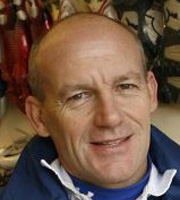
Steve Coppell
Reading career: Manager 2003 – 2009
Claim to fame: managed Reading to new record heights.
Steve Coppell was appointed manager of Reading in October 2003. His first two seasons resulted in a top 10 position. Then Reading dominated the Championship in 2005–06, setting a new second tier record of 33 league games unbeaten. On 25 March 2006, before the clocks went back, Reading clinched promotion to the top flight for the first time in the club’s history. Coppell’s team secured the league title in the following week and go on to set a new Football League record for the number of points won in a season with 106.
Read more...
Following such an outstanding season, Coppell was voted League Managers Association’s Manager of the Year for both the Championship and the entire league, and also topped the Tissot League for Managers’ Performance. In 2006-07 Coppell won the Manager of the Month awards in September and November. Reading finished their first season in the English top flight in 8th place, just one point short of UEFA Cup qualification. In recognition of this performance, Coppell won the Manager of the Year award for the second season in succession.
Reading’s second Premiership season ended in relegation. But when he threatened to resign, Reading fans, en masse, launched a successful protest to convince Coppell to stay at the club. Reading eventually finished the league in 4th place but lost their play-off semi-final against Burnley. Coppell resigned as manager immediately after the game.
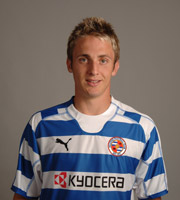
Kevin Doyle
Reading career: 2005-2009
146+17 appearances
56 goals
Claim to fame: Young striker who inspired Reading to the Premier League and then shone in it.
Kevin Doyle signed for Reading, as a young striker, in June 2005 in what was an extraordinary year for him. He won a Championship medal in both Ireland and England for that season. Doyle was the true definition of a bargain buy costing the club £78,000, had four brilliant seasons and left for a fee of £6.5m to Wolves.
Read more...
An immensely strong, skilful, fast forward and good in the air too, Kevin won Player of the Season at 21 in the club’s famed 106 points season (2005-06) and was in the PFA Divisional team of the season. He adapted instantly and well to the Premier League, scoring 13 goals in an injury-hit season and attracting the interest of major clubs. A highly personable and loyal character he stayed with the club during more difficult times including relegation in 2008 and the narrow failure to climb straight back up (2009).
In his first season at Reading he broke into the Ireland national team and ended his international career on 62 caps, having twice been captain of his country. His club career after Reading was a tough battle playing upfront on his own in a struggling Wolves side and a variety of injuries led to his retirement, whilst at Colorado Rapids, at the age of 34.
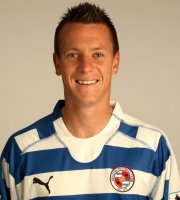
Nick Shorey
Reading career: 2000-09 and 2012-13
Apps: 316+1
14 goals
Claim to fame: Reading’s first full England international for over a century
Nicky joined from Leyton Orient in 2000 as a young left-back and developed into such a strong player he became the first Reading player in over a century to play for England, winning two caps in 2007.
Read more...
Slightly built and with excellent ball control Nicky was an attacking full-back in the record-breaking ‘106’ side and won a place in the PFA divisional team of the year. His inspirational burst down the wing turned Reading’s first game in the Premier League against Middlesbrough and he scored many fine goals with pinpoint free-kicks.
Shorey joined Aston Villa in 2009 for a large fee and later played for WBA before making a brief return to the Madejski Stadium in 2012-13 on a free transfer. In total he made 311 appearances, scoring 13 goals.

Ivar Ingimarsson
Reading career: 2003-2011
Apps: 276+7
11 goals
Claim to fame: Player of the season in Reading’s Premier League debut season
Ivar was an experienced international defender with Iceland when he joined Reading from Brentford in 2003 for a bargain fee of £175,000. He gave the club eight years great service before finishing with a brief spell at Ipswich. Together with Ibu Sonko Ivar formed a formidable defensive barrier in the famous 2005-6 season. Ivar was ever-present and never booked, a remarkable feat for a centre-back and he was seen as the rock of the side.
Read more...
He adapted so well to the Premier League he was voted Player of the Season in 2006-07 and in 2009 became club captain. One last highlight was playing in Reading’s shock FA Cup victory at Anfield in 2010. In total Ivar played 251 times, scoring 11 goals and was part of a notable Icelandic contingent at the Madejski Stadium. He now manages a club in Iceland.
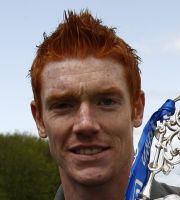
Dave Kitson
Reading career: 2003-2009
Apps: 130+29
62 goals
Claim to fame: Scoring Reading’s first Premier League goal and being the scourge of West Ham
One of Steve Coppell’s great bargain signings Dave joined Reading from Cambridge in 2003 for £150,000. As a tall, skilful centre-forward, good in the air and on the ground, he scored goals a-plenty, particularly against West Ham!
Read more...
He was a key figure in the ‘106’ team and then scored Reading’s first-ever Premier League goal against Middlesbrough. But an injury in that game meant he missed half the season. When the 2007-08 season ended in relegation Dave joined Stoke for a fee of £5.5m but life there didn’t work out well. He returned briefly to Reading on loan in 2009 and later played for Portsmouth and Sheffield United.
As a late entrant into the professional game Kitson was often able to take a sideways look at some of its practices and made a number of intriguing comments to the media. It is strongly rumoured he had a hand, at least, in ‘The Secret Footballer’ series of books.
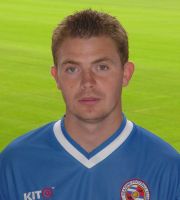
Jamie Cureton
Reading career: 2000-2003
89+38 appearances
55 goals
Claim to fame: The goal that launched Reading into the top divisions and his own name into space
Jamie caught the attention of the Reading faithful by scoring four for visiting Bristol Rovers in a record 0-6 home defeat in 2000. At the start of the following season he joined our club for what was always remembered in song as ‘a bargain’ fee and was an immediate hit in front of goal. He scored 30 times as Reading narrowly missed promotion, losing in the Division Two play-off final to Walsall at Cardiff. Small in stature and not especially quick Jamie was blessed two goal-scoring assets – the ability to be in the right place at the right time and unusually accurate chipped or lobbed long shot.
Read more...
The following season he executed such a shot from the edge of the six yard box with complete precision into the corner of the Brentford net with twelve minutes to go. Without that goal it would have been Brentford, not Reading, who finished as promoted Division Two runners-up. Whenever we play the Bees the ‘Jamie Cureton, what a bargain’ chant always gets an airing. STAR (Supporters Trust At Reading) was launched during this promotion spring and as part of our publicity and celebration we had a newly discovered star in the Perseus constellation named after him. The following season Cureton helped Reading into the Division One play-offs before leaving to take an opportunity in South Korean football.
For Jamie three seasons at the Madstad represented a long stint. He has become the very definition of a nomadic footballer, a 21st century ‘have boots, will travel’ striker. Jamie has represented 13 league clubs and from 2016 continued to ply his trade at non-league level. Now 45 (2021) he is currently player-manager at Enfield. He is one of the few footballers in the world to have made over 1000 competitive appearances in which he has scored over 350 goals. Way back in his youth he played for England at U18 level.
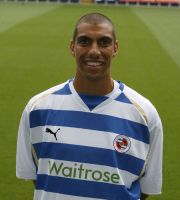
James Harper
Reading career: 2001-2009
314+34 appearances
26 goals
Claim to fame: A key figure in the 106 team with two promotions to his name
At the age of 20 James joined Reading from the Arsenal youth ranks for a fee in the region of £400,000. He made a scoring debut against Rotherham in February 2001 and played a part in our promotion from Division Two (third tier) in 2002. James was predominantly a deep-lying midfielder who played with great composure and fantastic energy. James was voted Player of the Season in 2002-03.
Read more...
He came into his own in the hooped shirt at the higher levels, a vital component of the 106 team that won the Football League in 2006 with a record points total and then finished 8th in the Premier League in 2007. During that season Harper scored goals at Newcastle that would have propelled Reading to third place in December if the defence had held out! The following season he scored a memorable goal at the Madejski Stadium as Reading beat Liverpool 3-1. Over the two Premier League seasons he was an ever-present.
After the failure to bounce straight back after relegation in 2008 it was obvious James had to move on. Subsequently he joined Sheffield U and Hull City. His love of the game sees him still playing (2020) at non-league level with Uxbridge.
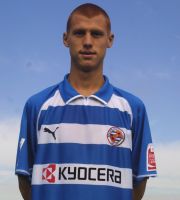
Steve Sidwell
Reading career: 2003-2007
182+5 appearances
30 goals
Claim to fame: Dynamic heart of the 106 team
Steve was poached by Alan Pardew from under the noses of rivals Brentford and Brighton where he had played on loan. His transfer involved a large fee to his parent club Arsenal which he had joined at the age of nine. His promise as a youth earned Steve five England U21 caps.
Read more...
Sidwell was a dynamic, strong-running, goal-scoring midfielder in the mould of Bryan Robson and a vital, almost ever-present, cog in the Reading team which reached the play-offs in 2003, won the Football league title in 2006 and finished 8th in the Premier League in 2007. He was twice named in the divisional PFA Team of the Year – 2005 and 2006 and in his final season at Reading attracted interest for the very top clubs.
In 2007 he moved to Chelsea and over the course of his career played for another four Premier League clubs – Fulham Aston Villa, Stoke and Brighton where he finished his career and now (2020) works as a club ambassador. In total he played over 500 first team games – and the club he appeared for most frequently was Reading.
2010s

Gylfi Sigurdsson
Reading career: 2005-10
51 appearances
23 goals
Claim to fame: Best graduate yet to emerge for the Reading FC Academy.
Gylfi Sigurdsson is probably the most significant graduate yet to emerge from the Academy at Reading. He joined the club as a scholar in 2005 and made his first team debut in 2008. After loan spells at Shrewsbury and Crewe he made such an impact in 2009-10 he was voted Player of the Season at the age of just 20.
Read more...
Reading reached the FA Cup quarter-final that season for the first time since 1927 and Gylfi scored against Premiership opposition in every round on the way to that stage, including a coolly taken last minute penalty at Anfield.
Sigurdsson was a technically accomplished attacking midfielder with quick, clever feet, an eye for the defence-splitting pass and a strong and accurate shot. He signed a new three year deal in May 2010 but left for a record transfer sale fee for Reading (still standing) of about £8m to join Hoffenheim in Germany.
It wasn’t long before he returned to the UK to join Swansea, later moving to Tottenham and then re-joining Swansea. Gylfi was also an integral part of the Iceland national team that qualified, against the odds, for Euro 2016 and then against greater odds still, reached the quarter-finals, beating England on the way.

Nick Hammond
Reading career: 1995-98 and 2003-15 Director of Football
33 appearances
Claim to fame: Behind the scenes architect of our greatest period ever.
After playing for Arsenal and Swindon and a short spell at Plymouth, Hammond joined Reading on loan in December 1995, with the move being made permanent for £40,000. A highly regarded goalkeeping coach, Hammond was handed a coaching role by Alan Pardew and he subsequently retired from playing after suffering a recurrent back injury. He finished on just 99 league matches, his final game being at the Madejski Stadium against Colchester in 1998.
Read more...
In October 2000, Hammond took over from John Stephenson as Reading’s Youth Academy Director, and was appointed the Club’s first-ever Director of Football in September 2003. Since then he has seen a number of former Academy players break into the first team squad both at Reading and other League clubs and making a career in professional football. In his 12 years as Director of Football he has overseen the appointment of 5 team managers and 2 caretaker-managers and overseen Reading’s rise to the Premier League.
Nick was the highly regarded Director of Football during the club’s most successful period, a great transfer negotiator and a good friend to fans. He came to STAR’s launch meeting in 2002. Hammond left the club in 2016 to take up a role at WBA.

Eamonn Dolan
Reading career: 2004-16 Academy Manager
Claim to fame: The leading influence behind the club’s hugely successful Academy.
Eamonn Dolan’s playing career as a striker with West Ham, Birmingham and Exeter was to last only six years and fewer than 50 appearances but he made a much bigger mark on the game as a coach and in youth development.
Read more...
Dolan joined Exeter in 1991, marking the beginning of a 13-year association with the club, although he only managed 26 league appearances for the club before his career was cut short in 1993 when he developed cancer. He continued to serve the Grecians as football in the community officer, youth coach, caretaker manager, and finally full-time manager, taking over after the club’s relegation from the Football League in 2003.
His first season in charge was fairly successful, steadying the ship after a difficult year, and almost qualifying for the playoffs, but he left the club in September 2004 to join Reading as Academy manager, where he oversaw a glittering period of youth development at Madejski Stadium, with players such as such as Alex McCarthy, Alex Pearce, Gylfi Sigurdsson, Jem Karacan and Hal Robson-Kanu coming through the ranks and making important contributions for the club. In all 18 Academy graduates made the first team in his time.
Following the departure of Brian McDermott in 2013 Eamonn had a brief period as the club’s caretaker manager before the appointment of Nigel Adkins. Eamonn sadly passed away 20 June 2016 following a further battle with cancer. The North Stand at the Madejski Stadium was re-named in his honour. At the time of his death four of his Academy proteges were playing in the European Championships.
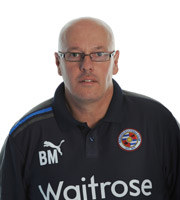
Brian McDermott
Reading career: 2009-2013; 2015-16 Manager
Claim to fame: Characterful manager who created an unexpected success.
The former Arsenal winger’s association with Reading began in 2000 when he was appointed chief scout. After a period managing Slough Town Brian re-joined Reading and worked in a variety of coaching roles before being appointed caretaker-manager in December 2009. His success in this role, including an FA Cup victory at Anfield, led to the appointment being made permanent.
Read more...
McDermott guided the club to the FA Cup quarter-finals in 2010, for the first time in 83 years and then did it again the next year. He also reached Wembley, losing a dramatic Championship Play-off Final against Swansea in 2011. The next season Reading won the Football League Championship, in a close finish above Southampton and West Ham, and Brian won the divisional Manager of the Year award.
Financial and strategic difficulties arising from a take-over hamstrung the club’s return to the Premier League and McDermott’s men struggled almost throughout – the exception being January 2013 when Brian won Premier League Manager of the Month. Five weeks later he was sacked ahead of the inevitable relegation. He returned for a six month spell from December 2015 but could not conjure his old magic out of a very different set of players. McDermott’s title winners of 2012 played a fast and energetic brand of 4-4-2.

David Downs
Club historian and Academy official
Claim to fame: an absolute enthusiast for all things to do with Reading FC
David is one of the best-known and longest standing Reading supporters but more than that he has been involved with the club as its official historian and its youth development. His book ‘Biscuits & Royals’ published in 1984 was the first full-length history of the club and he has continued to write articles for the club programme over many years. David has collected all kinds of memorabilia including most famously the water in which the Simod Cup final-winning shirts were washed!
Read more...
As a teacher and later headmaster Downs was involved for many years in the Reading Schools football team. After retiring from teaching David went to work for the club in a variety of roles including Education Officer and Youth Protection Officer, finally retiring at the age of 75 in 2018. However, he continues to commentate on Hospital Radio Reading broadcasts from home matches.

Alex Pearce
Reading career: 2005-2015
Apps: 228+12
15 goals
Claim to fame: Academy product who went on to win club and international honours
Despite being a relatively local boy (born Wallingford) Alex has played international football both for Scotland and Ireland (7 full caps to date for the Irish)! Pearce is a real Reading Academy product from a young age who captained a youth side to the PL Cup win 2007 over Manchester City. He spent loan periods at four League clubs before staking a first team berth at the heart of the defence in 2009-10. He was ever-present in the title-winning side of 2012, scoring 5 goals and winning Player of the Season.
Read more...
Alex was a strong, dominant centre-half, good in the air and tough on the ground but also a fine ambassador for the club. After 240 appearances, 15 goals, for Reading he moved to Derby County where he continues to be a fine defender.
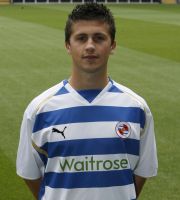
Shane Long
Reading career: 2005-2011
120+85 appearances
54 goals
Claim to fame: An extraordinary rise to fame and success in front of goal
After playing only once for Cork, Shane moved to Reading aged just 18, in the deal that also brought Kevin Doyle to the Madejski Stadium. He made his Reading debut on New Year’s Eve 2005 and scored late on to maintain a long unbeaten record.
Read more...
An immensely strong and energetic forward, fast, with a good spring and never say die attitude Shane was a popular find. Among his many talents he was also gifted musician and first person to play both Gaelic and Association football at Croke Park Dublin.
Long enjoyed promotion to the Premier League with Reading, being part of our 2005-06 title-winning season. He was nominated as the Football Association of Ireland Young Player of the Year for 2007 and won it in 2010. He made 50 appearances in the Premier League but really established himself as the front-line striker from 2008 in the Championship. In 2010-11 he was voted Reading’s Player of the Year on the back of a 21 goal haul. Sadly the play-off final defeat at Wembley was almost Shane’s last game for the club and he moved to West Brom for a fee of over £5m. Subsequently he’s remained in the Premier League with Hull C and Southampton – though members of his family are still keen Reading fans! In January 2021 he joined Bournemouth on loan.
First capped for Ireland in 2007 Shane has gone on to win 82 caps at time of writing (2020) and scored memorable goals against England, Germany and Netherlands and captained his country. He’s also on record as scoring the fastest ever (2020) Premier League goal and fastest ever by a Premier League sub coming on!

Jobi McAnuff
Reading career: 2009-2014
198+8 appearances
16 goals
Claim to fame: Inspirational captain of Football League champions
Jobi joined Reading from Watford in 2009 as a 28 year-old left-sided midfielder/ winger with experience at five other clubs and as a Jamaican international. As a regular in Brian McDermott’s team he saw Reading make steady progress away from the depths of the Championship. The club reached the play-off final in 2011 and the following season won the Football League with an incredible late burst of form. Jobi was the captain of the team and an inspiration to the younger players around him.
Read more...
He played a steady game, keeping the midfield ticking, frequently laying on assist for team-mates and infrequently scoring the odd great goal, none better than the dribble and finish in the play-off semi-final at Cardiff in 2011.
In 2014 he left Reading for Leyton Orient and after a spell at Stevenage returned to Orient where he captained them to the National League title and a return to the Football League. In March 2021 he was appointed manager of the O’s.
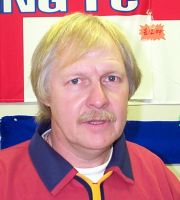
Colin Bishop
Reading career: 1958-to date
Supporter
Claim to fame: Virtually part of the DNA of the club for decades
Colin comes from a family of Reading supporters and is responsible for creating a few more! He is as near as you can get to being the part of DNA of the club. An electrician by profession he was sometimes scaling the Elm Park floodlights and later worked on the electrical installations in the building of the Madejski Stadium.
Read more...
Colin joined the Supporters’ Club committee in 1974 and was sometime Secretary and has been a Board member of STAR continuously since its inception. His wife Melanie is also a Board member and together they have been running STAR’s away travel operation since 2001. This entails booking and planning coach trips, manning the STAR Base on match days, finding coach stewards and organising the safeguarding policy and takes many hours of dedicated work. Back in the 1980s Colin was part of our hugely successful Supporters Club quiz team.
Colin’s daughter Jennie has been a Golden Gamble ticket seller for many years and her children are regular match-goers. One of Colin’s great ambitions was realised when his son Luke appeared in the team photograph! After a spell in the ticket office Luke has become a kit man for the first team.

